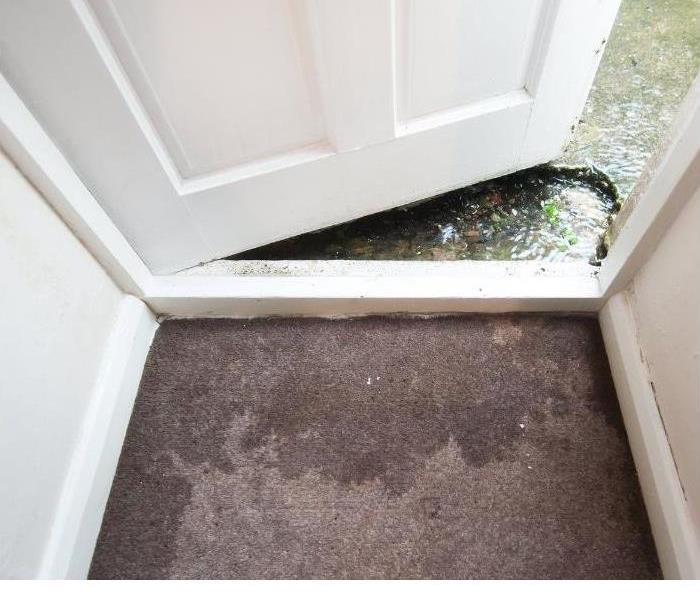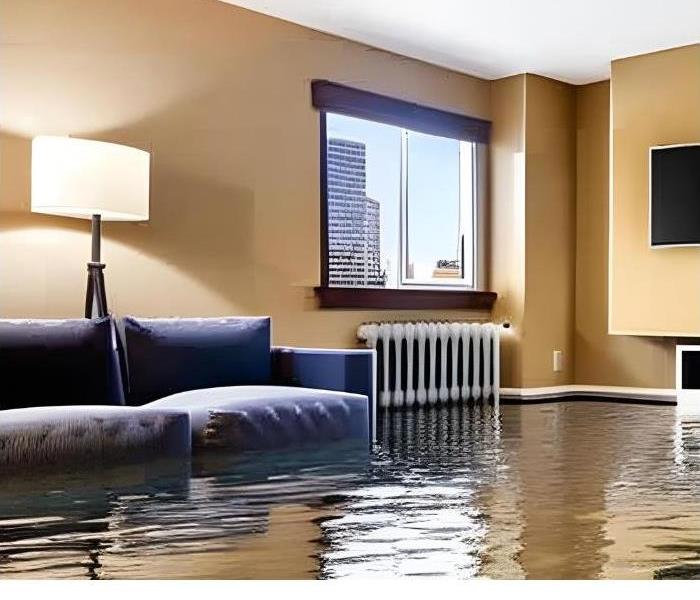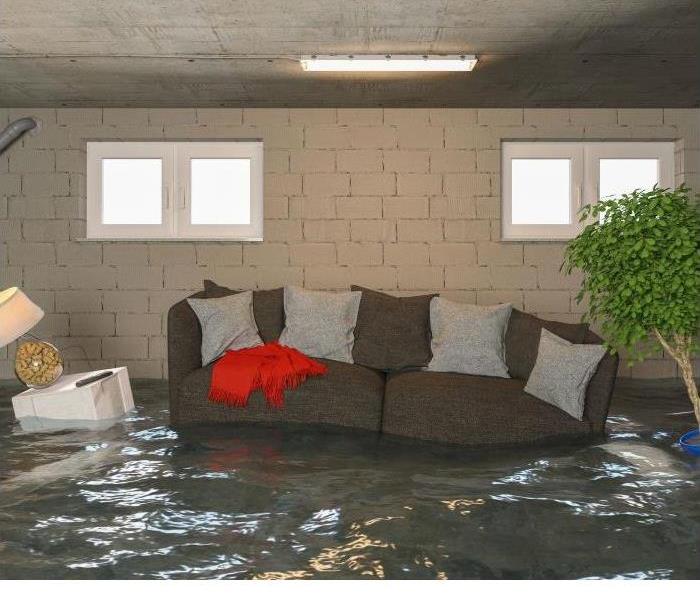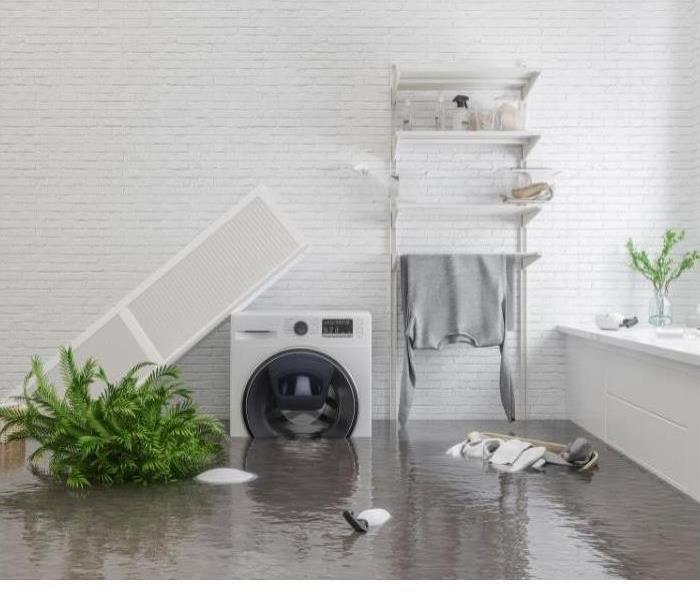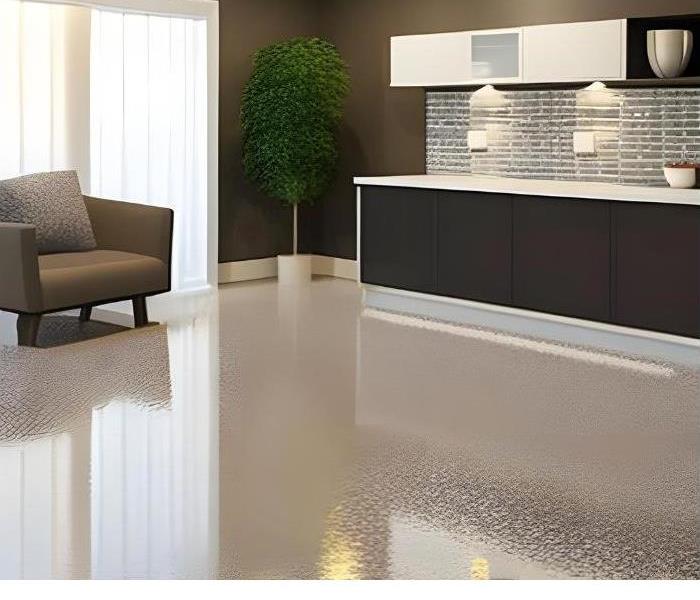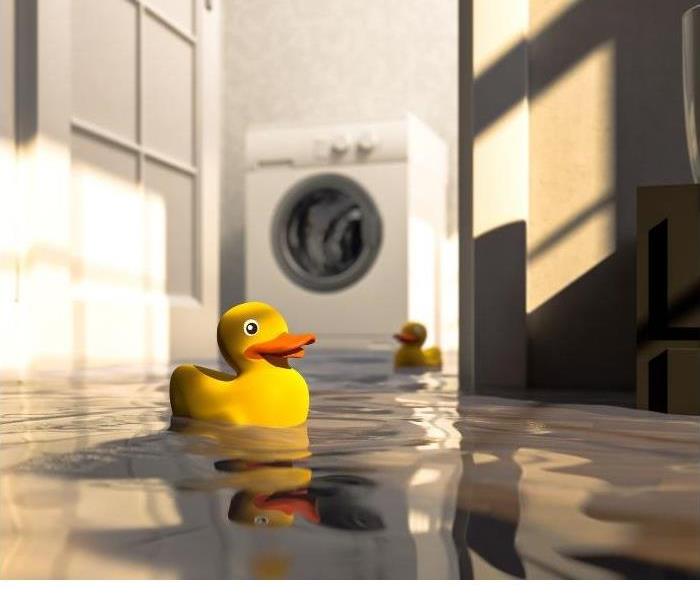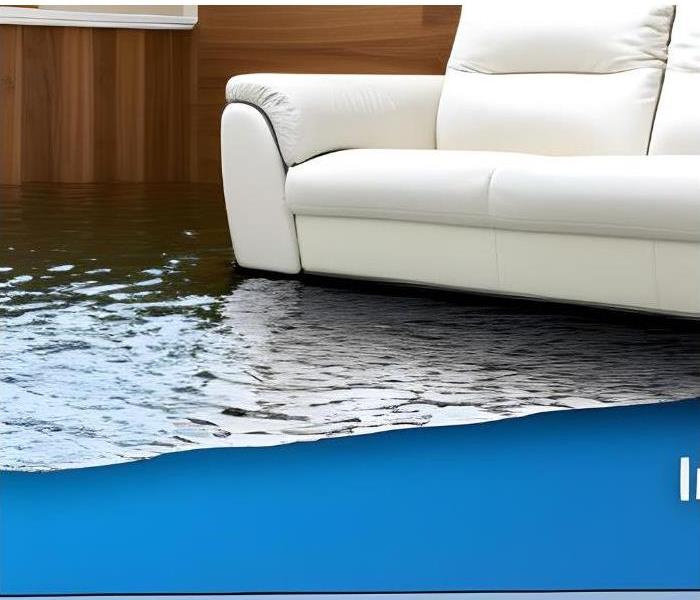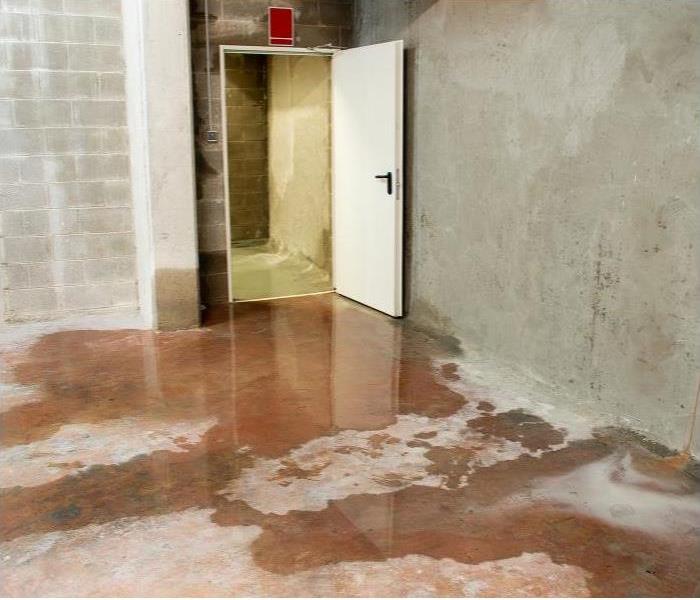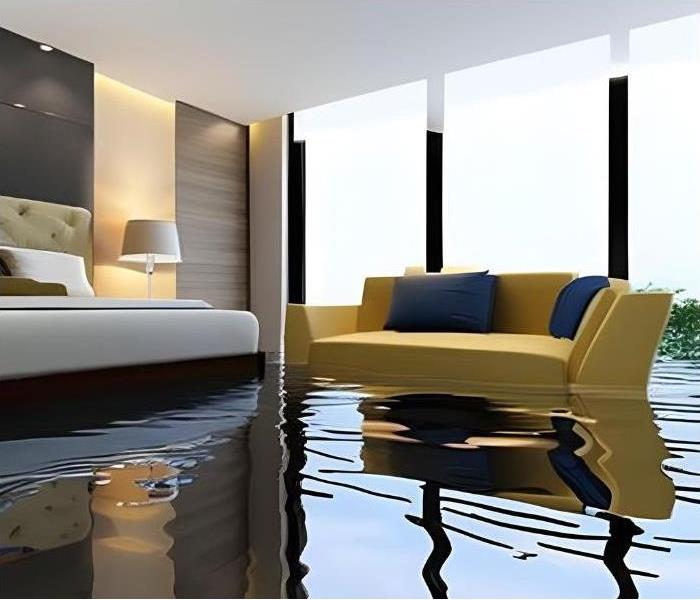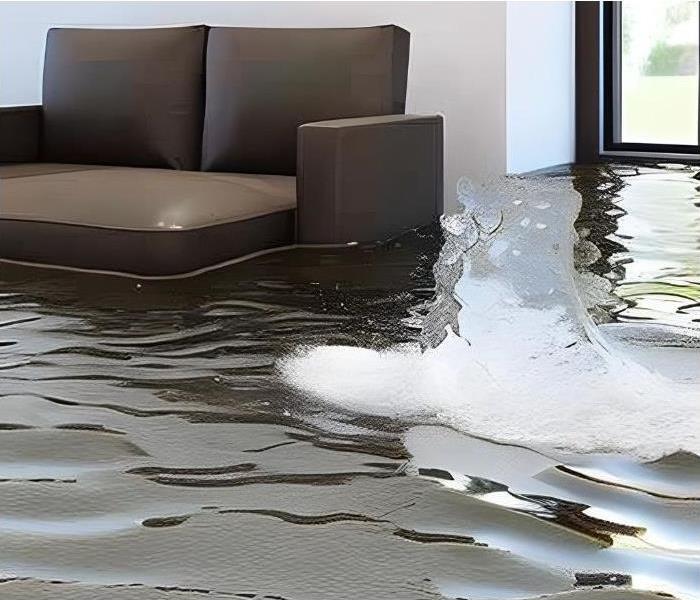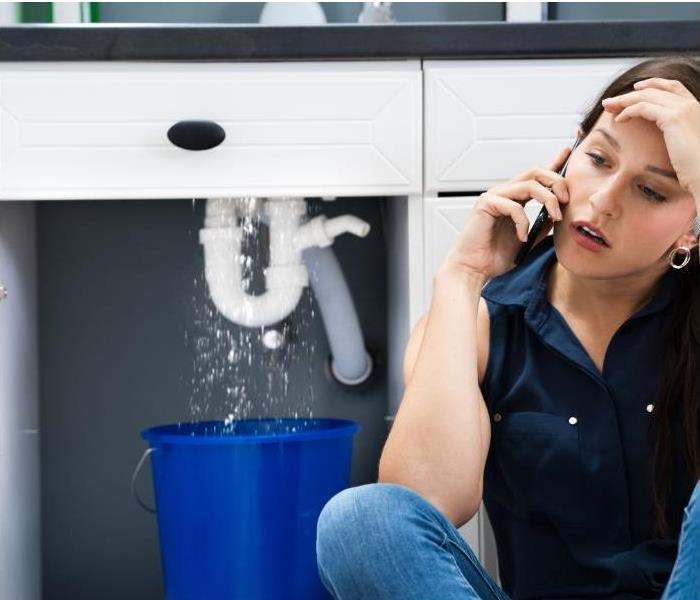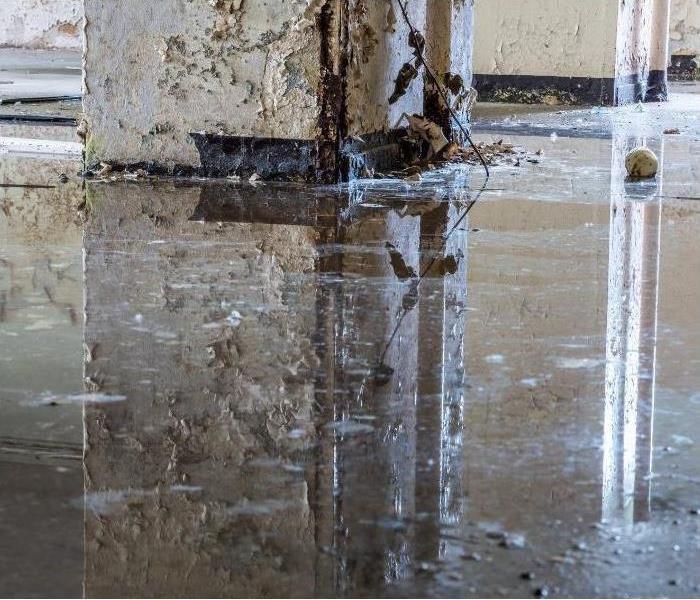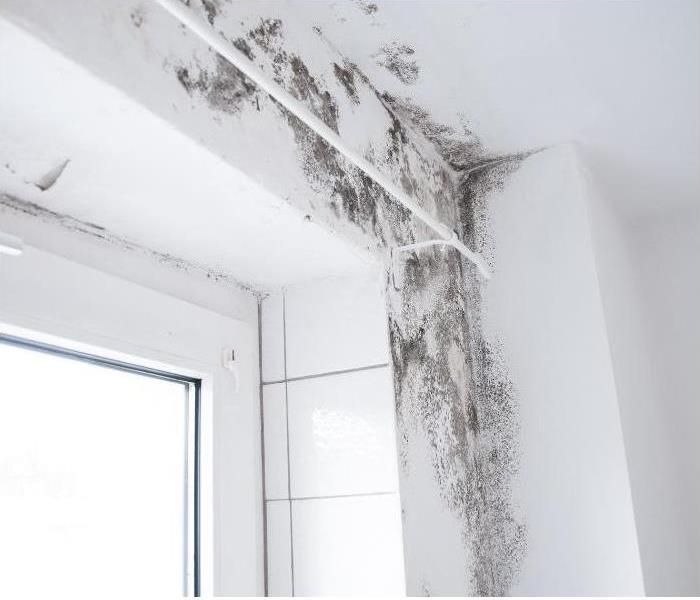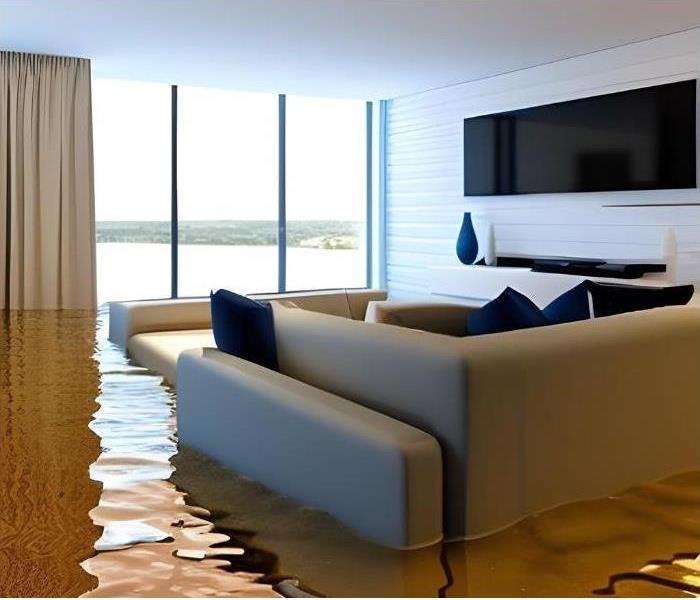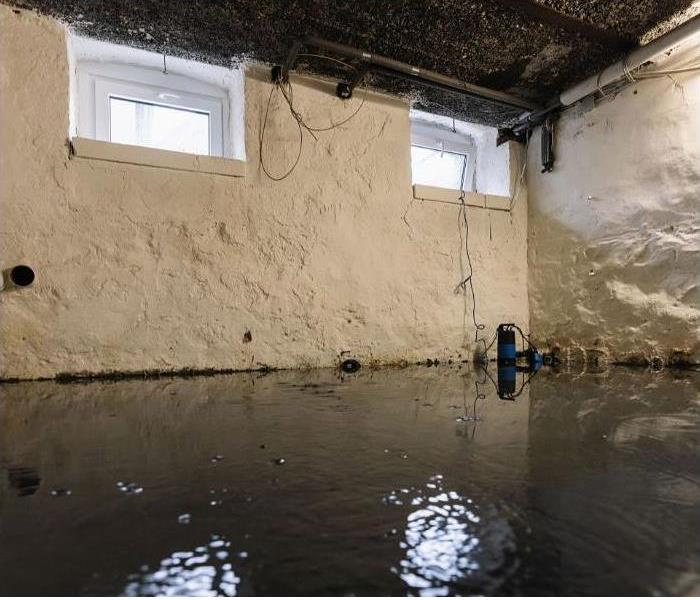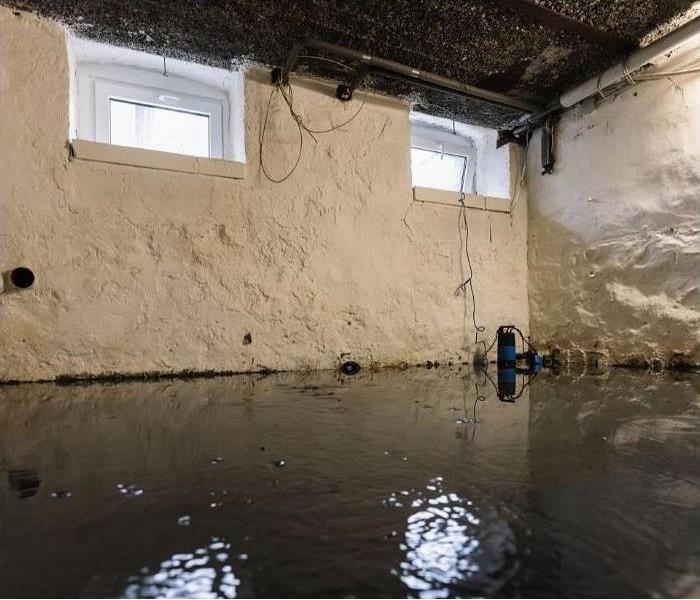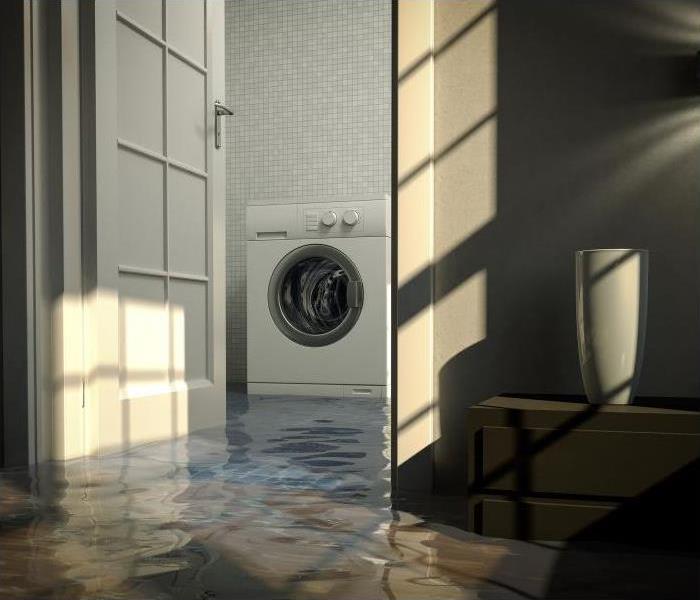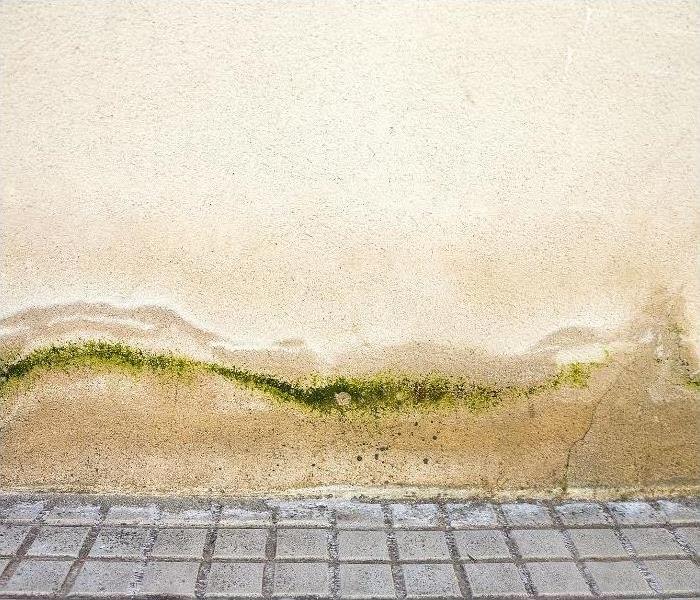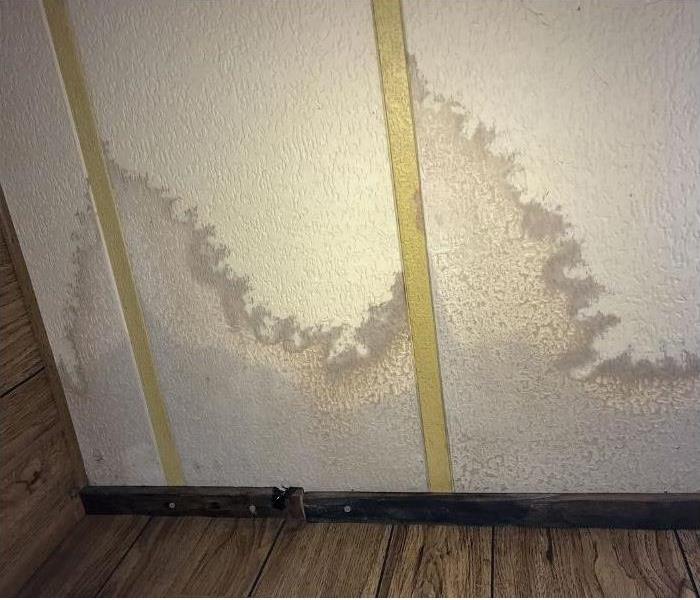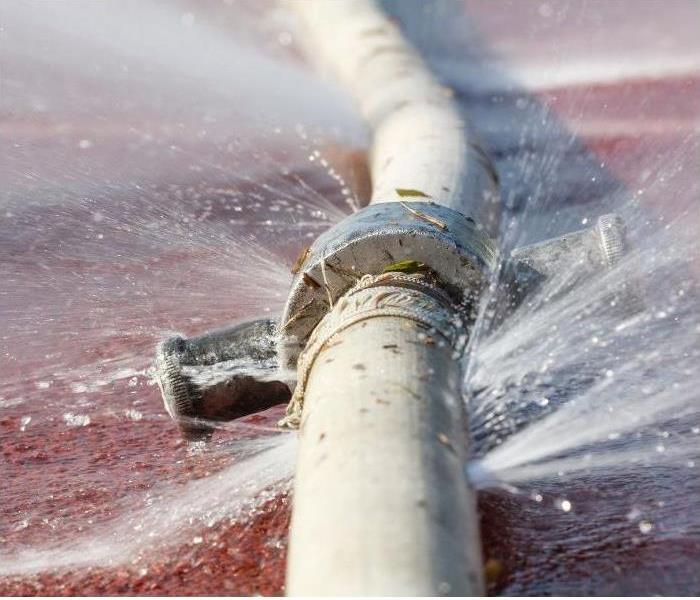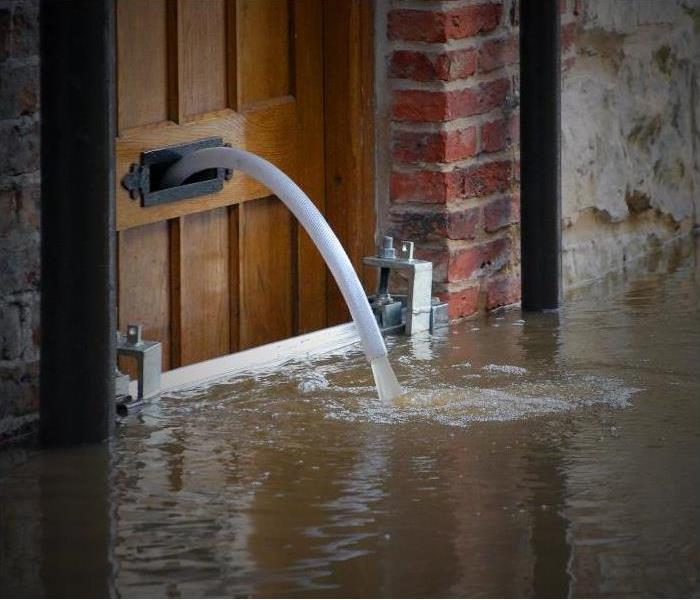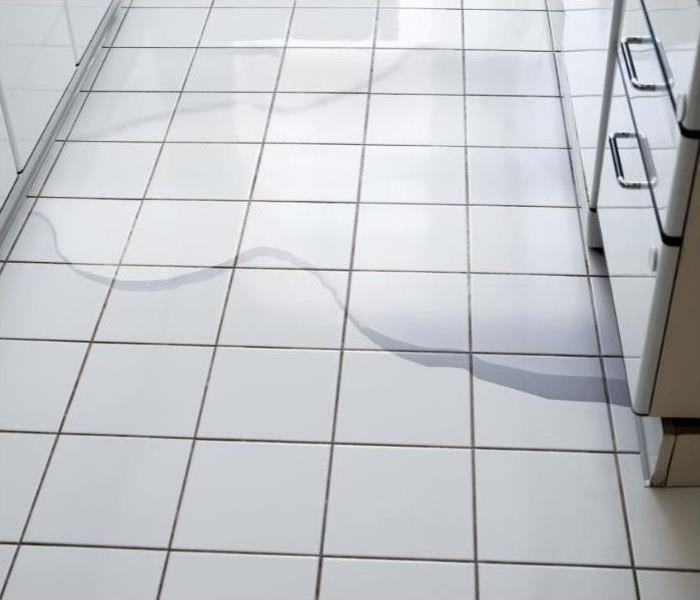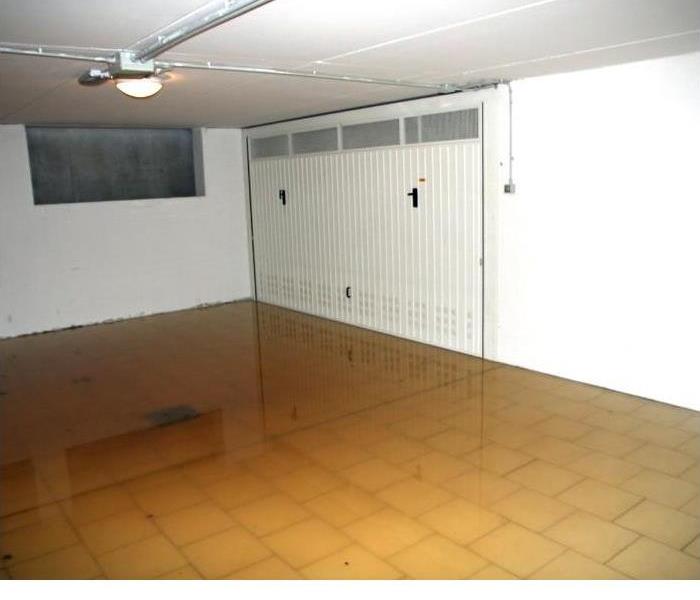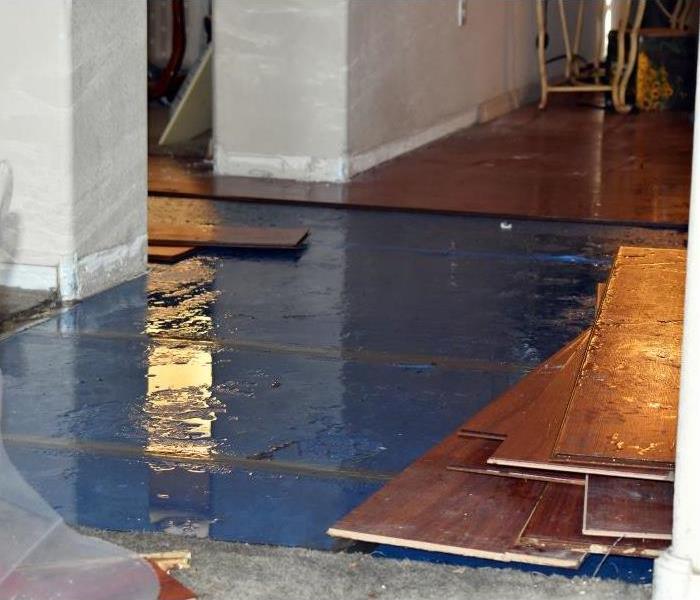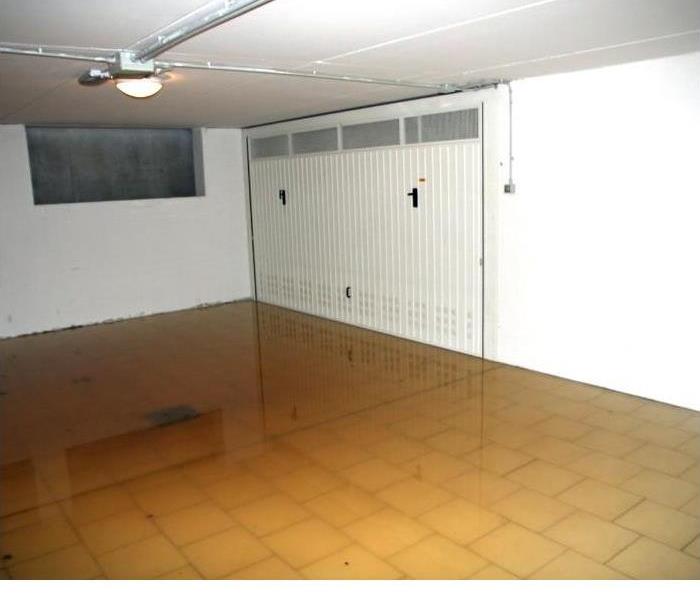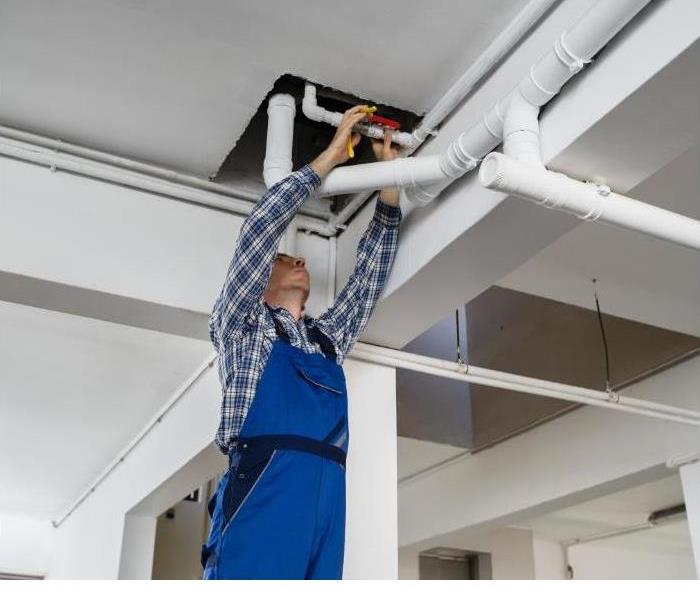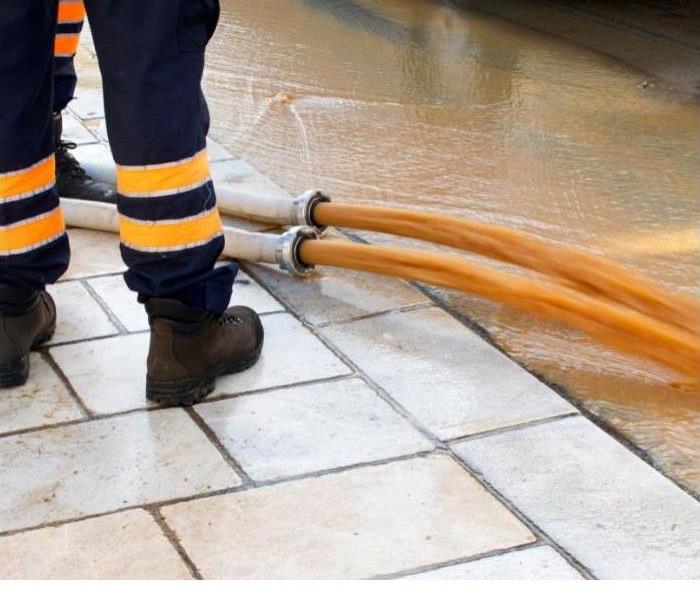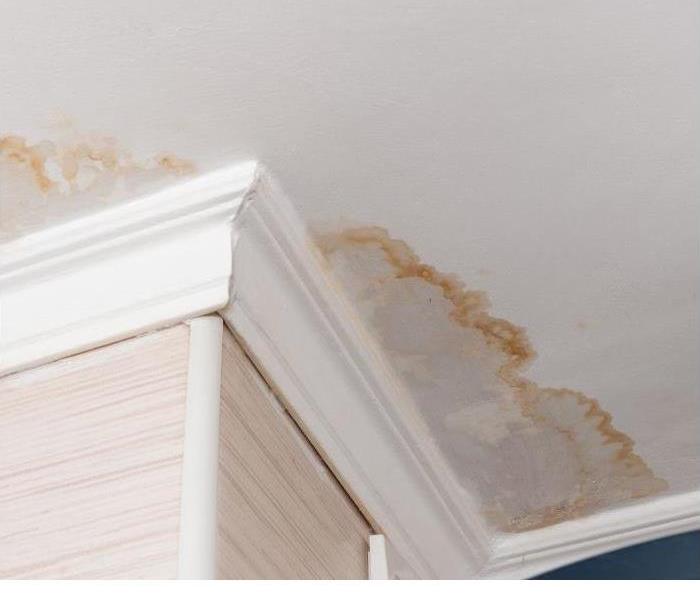Recent Blog Posts
Comprehensive Guide to Preventing Water Damage: Protect Your Home and Health
8/17/2023 (Permalink)
Water damage can lead to significant issues in homes, from structural instability to potential health risks. Recognizing the importance of preventing water damage, understanding its causes, and knowing how to address it promptly can safeguard your home and health. In this guide, we explore practical ways to prevent water damage, delve into the health risks involved, and discuss best practices in addressing potential problems.
Types and Signs of Water Damage
Water damage is not always a visible gushing leak or a significant flood. Sometimes, it presents subtly with signs like peeling paint, musty odors, mold growth, or a sudden spike in water bills. There are different types of water damage, often categorized based on their sources like leaking pipes, roof leaks, HVAC problems, and natural disasters.
Causes of Water Damage
Knowing what causes water damage can help homeowners take proactive measures to prevent it. Regular checks for plumbing issues, roof leaks, cracks in the foundation, faulty appliances, and potential HVAC condensation problems are essential. Weather-related water damage due to natural disasters such as hurricanes and floods also requires due consideration and preparedness.
Preventing Water Damage
Water damage prevention is an integral part of home maintenance. Here are some practical tips:
Regular Home Inspection
Regular inspections can help spot potential problems early. Check your roof for damages, ensure your gutters are clean and properly channeling water away from your house, and inspect your foundation for cracks.
Plumbing Checks
Make it a habit to inspect your plumbing systems and appliances for leaks regularly.
Installing Water Detection Devices
Consider installing water detection systems that can alert you to leaks and potential flooding.
Seasonal Maintenance
Certain seasons can increase the risk of water damage. Ensure your home is prepared for these seasonal risks, like winterizing your pipes to prevent them from freezing and bursting.
Water Damage and Health Risks
Water damage can lead to various health risks, especially if left unaddressed. The damp environment promotes mold and mildew growth, which can trigger allergic reactions and respiratory issues. It's crucial to prevent water damage to protect not just your home but your health as well.
Water Damage Restoration
In instances of water damage, the key is prompt and effective restoration. Homeowners can do minor water damage repair, but significant issues require professional restoration services. A professional water damage restoration process includes assessing the damage, water extraction, drying and dehumidification, cleaning, sanitizing, and finally restoring your home to its pre-damage condition. It's also crucial to understand the potential costs of water damage restoration.
Water Damage Insurance
Understanding your homeowner's insurance policy is essential when dealing with water damage. Policies differ in their coverage, and some may not include specific types of water damage. It's also worth considering flood insurance, especially for homes in flood-prone areas.
Emergency Preparation and Response
Being prepared can make a big difference when facing potential water damage. Knowing what to do immediately following water damage, how to practice safety during the cleanup, and having an emergency action plan are all crucial aspects of water damage preparedness.
Conclusion
Preventing water damage is an ongoing process that requires regular maintenance, timely inspections, and a good understanding of your insurance coverage. Inculcating preventive measures and understanding the potential health risks can help protect your home and ensure your family's safety. By implementing the best practices laid out in this guide, you can mitigate risks and handle any water damage situation effectively.
Understanding the Health Risks Associated with Water Damage: A Comprehensive Guide
8/17/2023 (Permalink)
Water damage is a common yet often underestimated problem that many homeowners face. It can occur due to various causes such as natural disasters, leaky pipes, or structural issues, leading to a host of structural safety issues and potential health risks. This comprehensive guide aims to discuss the various health hazards linked to water damage and how homeowners can effectively mitigate these risks.
Immediate and Long-Term Effects of Water Damage
Immediate Effects
In the immediate aftermath of water damage, the primary concern is often physical destruction—collapsed ceilings, damaged furniture, and ruined personal items. Electrical issues are also common and pose significant safety hazards.
Long-Term Effects
The long-term effects of water damage can be even more serious. Chronic dampness can lead to the growth of mold and mildew, affecting indoor air quality and leading to a range of health problems. Structural degradation over time can also make the building unsafe to inhabit.
Health Risks Associated with Water Damage
Mold and Mildew Risks
One of the most significant health risks associated with water damage is the growth of mold and mildew. These fungi thrive in damp conditions and can lead to respiratory issues, allergic reactions, and even toxic mold syndrome, caused by particularly harmful varieties like black mold (Stachybotrys chartarum).
Water Contamination
Water damage can also lead to water contamination, causing a range of gastrointestinal issues and infections. This is especially prevalent in the case of sewage backups, where harmful bacteria and pathogens can enter the living spaces.
Psychological Effects
Dealing with water damage and its aftermath can also lead to stress and anxiety, impacting mental health.
Preventing Water Damage
Understanding and implementing preventive measures can drastically reduce the risks associated with water damage. Regular building inspections to detect any structural issues or potential water intrusion sources like leaky pipes can help nip the problem in the bud. Using dehumidifiers in damp spaces like basements can also prevent mold growth.
The Importance of Water Damage Restoration
When water damage does occur, timely and effective restoration is crucial. Professional restoration services can dry out the area, remove damaged materials, and treat the space for mold and mildew, reducing potential health risks.
Safe Cleaning Practices
Following safe cleaning practices after water damage is essential to protect your health. These include using appropriate safety equipment, such as gloves and masks, to protect against mold exposure, and ensuring thorough drying and deodorizing to prevent future mold growth.
Legal Aspects and Insurance Claims
Understanding the legal aspects of water damage, such as your rights as a tenant or landlord and how to make insurance claims, can help you navigate the aftermath. Professional restoration services often offer advice on these matters.
Conclusion
Water damage poses significant health risks, but understanding these risks and taking appropriate preventative and remedial action can protect you and your loved ones. Whether it's taking preventive measures, following safe cleanup practices, or hiring professional restoration services, being proactive can make a world of difference in the face of water damage.
Remember, when dealing with water damage, immediate action is crucial. Even seemingly minor issues can lead to significant health problems if not addressed promptly. Stay informed, stay prepared, and ensure your home remains a safe and healthy space for you and your family.
Comprehensive Guide to Preventive Measures for Water Damage: Best Practices, Restoration, and Insurance Coverage
8/17/2023 (Permalink)
Water damage is a pervasive problem that many homeowners and property managers contend with. Whether it arises from floods, leaks, or heavy rains, the resulting damage can be both costly and harmful to the health of the property's occupants. However, with a keen understanding of preventive measures for water damage and the various types of water damage that can occur, you can mitigate potential harm and save significant time and money.
Identifying Types of Water Damage
Before we delve into preventive measures, it's essential to understand the types of water damage that can occur:
Flood Damage
Floods can cause extensive harm, leading to structural damage and potential mold growth.
Water Leaks: Commonly found in pipes, water heaters, and roofs, leaks can lead to long-term damage if not addressed promptly.
Heavy Rains
Over time, consistent rainfall can seep into your home's foundation, resulting in dampness and, eventually, damage.
Spotting the Signs of Water Damage
Next, we'll identify some key signs of water damage. They may include:
- Discoloration of walls or ceilings
- A musty smell, indicating potential mold growth
- Soft spots in your flooring, especially in the bathroom or kitchen
- Unusually high water bills, which could suggest a hidden leak
The Impacts of Water Damage
Water damage can have significant physical, financial, and health impacts. Physically, it can lead to structural damage, necessitating costly repairs. Financially, without proper insurance coverage, you could face steep out-of-pocket expenses for water damage restoration. Health-wise, unchecked water damage can lead to mold and mildew growth, posing potential respiratory issues and other health risks.
Essential Preventive Measures for Water Damage
Prevention is always better than cure, and here are some of the best practices to prevent water damage:
Regular Maintenance
Ensure that all the water systems, including pipes, gutters, and HVAC units, are regularly checked and maintained.
Waterproofing
From basements to roofs and walls, a good waterproofing solution can drastically reduce the chances of water damage.
Proper Landscaping
Slope your yard away from your home to prevent water from pooling around your foundation.
Installation of Water Leak Detection Systems
These systems can help identify leaks early before they cause significant damage.
Professional Water Damage Services
For larger properties or more complex issues, consider engaging professional water damage services. These services offer comprehensive solutions, including water damage repair, mold prevention, and emergency water damage control.
Insurance Coverage for Water Damage
Finally, a key aspect of water damage prevention is understanding your insurance coverage. Standard homeowner's insurance may cover some forms of water damage, but not all. You may need to explore additional coverages, such as flood insurance, for more comprehensive protection.
DIY Tips for Water Damage Prevention
For homeowners wanting to take matters into their own hands, here are a few DIY tips:
Regularly check your roof for damage and ensure your gutters are clean and free of debris.
Use water-resistant construction materials whenever possible.
Install a sump pump in your basement if flooding is a concern.
Concluding Thoughts
Water damage prevention requires knowledge, preparation, and vigilance. By understanding the types of water damage, spotting signs early, taking preventative measures, and ensuring you have the right insurance coverage, you can protect your property from the destructive and costly effects of water damage. Whether you decide to take the DIY route or seek professional assistance, the key is to act early and prioritize regular maintenance to prevent damage before it occurs.
With the right approach, you can ensure the health and longevity of your property, saving you time, money, and stress in the long run. Remember, it's always better to prevent water damage than to repair it.
Understanding Mitigation Vs. Restoration: A Comprehensive Guide to Disaster Management
8/17/2023 (Permalink)
Mitigation and restoration form the backbone of disaster management, playing crucial roles in risk reduction and recovery. This in-depth article provides a comprehensive overview of these two processes, their differences, and their practical applications in various scenarios.
Defining Mitigation and Restoration
Mitigation and restoration are both vital components of disaster response and management. Mitigation refers to the proactive measures taken to minimize the impact of disasters, including disaster preparedness, risk reduction strategies, and hazard prevention. Restoration, on the other hand, is the process of repairing or returning an environment to its pre-disaster state, involving structural repairs, disaster recovery planning, and post-disaster reconstruction.
The Processes of Mitigation and Restoration
Each process involved in mitigation and restoration has its own unique set of stages. Mitigation involves comprehensive planning, assessing potential risks, and implementing measures to reduce these risks. Restoration follows disaster events and includes activities such as damage assessment, cleanup, repair, and reconstruction to restore affected areas to their former state.
Mitigation
Mitigation is the act of reducing the severity of a situation and preventing further damage after a disaster, such as water, fire, or storm.
Restoration
Restoration is when experts rebuild or repair the property to its pre-disaster condition, restoring its functionality and appearance.
Role in Disaster Management
Mitigation and restoration form integral parts of disaster management. From flood control measures, and fire safety techniques to climate resilience strategies, they play an essential role in dealing with natural disasters like floods, fires, and earthquakes.
Case Studies and Examples
Various case studies highlight the effectiveness of mitigation and restoration efforts. These range from flood mitigation measures in flood-prone areas, and fire restoration efforts post-wildfires, to biodiversity conservation and ecosystem repair initiatives following environmental disasters.
Environmental Aspects
Environmental mitigation and restoration involve specific strategies aimed at preserving and recovering ecosystems. These include soil stabilization, wildlife habitat restoration, and erosion control. These strategies contribute significantly to environmental protection and biodiversity conservation.
Tools and Equipment
Different types of equipment and technology are used in mitigation and restoration. This can range from emergency response tools in disaster relief services to specific equipment for water damage restoration, fire safety, and more.
Best Practices
Best practices in mitigation and restoration are continually evolving. They involve a comprehensive approach that includes risk assessment, effective planning, timely response, and efficient use of resources. Emergency management best practices are also crucial for a successful mitigation and restoration process.
Economic Considerations
The economic aspects of mitigation and restoration involve understanding the costs associated with these processes and finding effective ways to finance them. Insurance plays a critical role here, with insurance claims for disasters often being a significant source of funding for restoration efforts.
Legal Regulations and Compliance
There are various regulations in place related to mitigation and restoration. These regulations aim to ensure the highest industry standards are met during these processes. Compliance with these regulations is crucial for successful mitigation and restoration efforts.
Professional Services
Professional services in mitigation and restoration involve a range of specialists who offer expert assistance in different areas. These can range from disaster recovery planners, restoration professionals, emergency response teams, and more.
Certifications and Training
Certifications and training in mitigation and restoration provide the necessary skills and knowledge required to effectively manage and respond to disasters. These programs offer comprehensive education on the various aspects of mitigation and restoration, including emergency response, risk reduction, disaster recovery planning, and more.
The Future of Mitigation and Restoration
The field of mitigation and restoration is continually evolving, with new strategies and technologies emerging regularly. Future trends may involve greater use of technology in disaster response, more focus on climate resilience, and continued emphasis on environmental preservation and restoration.
Conclusion
Understanding mitigation vs. restoration is vital for effective disaster management. By applying best practices and continually adapting to new challenges and developments, it's possible to minimize disaster impacts and facilitate recovery when disasters do occur.
The Comprehensive Guide to Successfully Filing Insurance Claims for Water Damage
8/17/2023 (Permalink)
Water damage can be a homeowner's worst nightmare, but having a comprehensive insurance policy in place can alleviate much of the financial burden. Understanding how to successfully navigate the claim process is key. This in-depth guide will provide you with valuable insights on filing insurance claims for water damage and help you manage the situation efficiently.
The Basics of Filing Insurance Claims for Water Damage
Water damage can be caused by a variety of incidents, including burst pipes, roof leaks, natural disasters, or a simple water leak. The extent of the damage can range from mild to severe, but no matter the scale, it's crucial to understand your homeowner's insurance policy and what it covers.
Understanding Your Insurance Policy
Your homeowner's insurance policy is your primary tool for disaster recovery. It's important to be familiar with your policy's inclusions and exclusions, particularly in relation to water damage. Understanding terms like 'replacement cost' versus 'actual cash value' can also significantly impact your claim.
The Process of Filing a Water Damage Insurance Claim
The claim process starts with documenting the damage. Taking thorough photos and videos can help your claim's success. Notify your insurer promptly to start the claims process. Be prepared to fill out forms and wait for the adjuster’s visit, which will assess the extent of the damage and estimate repair costs.
Insurance Policy Review
Review your insurance policy and understand what types of water damage are covered and what is excluded.
Contact Your Insurance Company
Contact your insurance company as soon as possible after the water damage occurs and provide them with the necessary information, such as the cause and extent of the damage, the date and time of the incident, and your policy number
Dealing with Insurance Adjusters
Dealing with insurance adjusters can be a tricky process. Being prepared with your documentation and understanding the extent of your coverage can help in negotiating a better settlement. If you disagree with the adjuster's findings, it is within your rights to contest them.
Repair and Restoration After Water Damage
Once the claim is approved, the repair and restoration process begins. Select a reliable water damage restoration service that can restore your home effectively. This may include water damage cleanup, structural repairs, and possibly mold damage repair.
Common Mistakes When Filing Water Damage Insurance Claims
Avoid common mistakes such as failing to document all damages, not understanding your policy's specifics, or waiting too long to file the claim. Being proactive and knowledgeable will help ensure the process is as smooth as possible.
Dealing with Claim Denials
If your water damage claim is denied, it's not the end of the road. You can appeal the decision, and understanding the reason for denial will assist in making a successful appeal.
Preventing Future Water Damage
Prevention is the best way to avoid dealing with water damage and the resulting claims process. Regular maintenance, including checking pipes and the roof for potential issues, can help prevent major water damage incidents.
Conclusion
Filing insurance claims for water damage can be a daunting process, but understanding your insurance policy and the steps involved can make it more manageable. By being prepared and proactive, you can navigate the process with confidence and successfully restore your home.
Remember, when dealing with water damage, acting quickly can mitigate further damage, expedite the claim process, and help you return to normal life sooner.
This article aimed to be a comprehensive guide, but always refer to your insurance policy and consult with professionals for advice tailored to your situation.
Demystifying Insurance Claims: A Comprehensive Guide to Water Damage and Coverage
8/17/2023 (Permalink)
Water damage is an all-too-common occurrence for homeowners across the nation. Whether it's due to a natural disaster, a leaking roof, or a burst pipe, the havoc it can wreak on your property is extensive and costly. Amid this chaos, understanding how your insurance policy responds to such incidents can ease your stress and aid your recovery. This comprehensive guide delves into the world of insurance and water damage to help you navigate this complex territory more easily.
Understanding Water Damage
Water damage is a broad term that encompasses various types of damage caused by water intrusion into your home. These may include:
- Flooding from severe weather conditions
- Leakage from a faulty pipe or appliance
- Sewer or septic tank backups
- Moisture trapped in walls leads to mold growth
- When left unattended, water damage can lead to structural instability and mold growth, creating a health hazard for the occupants. It's essential to act fast by contacting a water damage restoration service.
Navigating Your Insurance Coverage
Understanding your insurance policy's coverage can be overwhelming. Policies can vary widely, and knowing whether your home insurance covers water damage is crucial.
Homeowner's Insurance
Most standard homeowner's insurance policies cover sudden and accidental water damage, like a burst pipe or a leaking appliance. However, they generally exclude damage resulting from poor maintenance or negligence.
Flood Insurance
Standard homeowner's policies do not cover flooding caused by natural disasters. For such coverage, you'll need a separate flood insurance policy, typically available through the National Flood Insurance Program.
The Claims Process: How to File a Water Damage Insurance Claim
Navigating the water damage claim process can seem daunting, but taking it step-by-step can ease the procedure:
- Document the Damage: Take photographs and videos of the affected areas, noting any structural damage and damaged belongings.
- Contact Your Insurance Company: Notify your insurer about the damage as soon as possible.
- Meet the Adjuster: The insurance company will send an adjuster to inspect the damage.
- Restoration and Repair: After approval, the process of water cleanup and property restoration begins.
- Claim Settlement: After all repairs are done, the claim is finalized and payment issued.
Preventive Measures to Ward Off Water Damage
Prevention is better than cure, and this stands true for water damage. Simple measures can go a long way in preventing such instances:
- Regularly inspect and maintain your plumbing systems
- Install a water leak detection system
- Ensure your home is properly waterproofed
- Regularly inspect roofs and gutters
Insurance and Water Damage: What You Should Know
Understanding how insurance handles water damage is key to filing successful claims:
- Water Damage vs. Flood Damage: Water damage is usually covered by homeowner's insurance, while flood damage requires a separate flood insurance policy.
- The Impact on Future Insurance Rates: Filing a water damage claim can increase your future premiums.
- Exclusions and Limitations: Not all types of water damage are covered. It's vital to understand your policy's exclusions and limitations.
- Mold and Water Damage: If mold results from a covered water damage incident, the remediation process might be covered by your insurance.
- Claim Disputes: If your claim is denied or you're unhappy with the settlement, consider hiring a public adjuster or an attorney specializing in property insurance.
Conclusion
Navigating the intricacies of insurance and water damage can be a daunting task. However, with the proper knowledge and resources, you can ensure that you're adequately covered. Remember, an understanding of your insurance policy can mean the difference between a manageable recovery and a financial disaster.
Understanding the Differences: Flood Damage vs. Water Damage – A Comprehensive Guide
8/17/2023 (Permalink)
As an expert in property restoration and the intricacies of water-related damages, we understand that homeowners and property managers are often confused about flood damage and water damage. This comprehensive guide aims to clearly outline their causes, differences, effects, and recovery processes, as well as provide advice on insurance coverage, prevention, and mitigation.
Property damage resulting from water intrusion is a common issue faced by homeowners worldwide. However, the source of the water makes a significant difference in terms of insurance coverage, damage assessment, cleanup procedures, and more. This distinction is between flood damage and water damage.
What is Water Damage?
Water damage is typically caused by problems within the house. Examples include water leaks, burst pipes, sewage backup, a roof leak, a malfunctioning sump pump, or a broken appliance, among others. It's crucial to detect water damage early, as it can lead to further issues such as structural damage, mold growth, and other health risks if left unchecked.
What is Flood Damage?
Flood damage is defined by the Federal Emergency Management Agency (FEMA) and insurance companies as damage caused by water from a natural source that inundates land that's usually dry. This can include flash floods, storm surges, overflow of a body of water, or mudflows.
The Key Differences Between Flood and Water Damage
Insurance Coverage
Homeowner's insurance typically covers water damage, but flood damage is only covered under a separate flood insurance policy.
The Extent of Damage
Floods can affect larger areas and cause more severe damage, including severe structural damage, loss of property, and potential displacement.
Cleanup and Restoration
Both require immediate attention, but flood damage may necessitate more intensive cleanup due to potential contamination from sewage and other hazardous materials.
Preventing Water and Flood Damage
Water Damage
- Regularly inspect and maintain household appliances
- Check plumbing systems for leaks
- Ensure the roof is in good condition to prevent leaks
- Install a sump pump if the basement is prone to flooding
Flood Damage
- If possible, elevate your home if it's in a flood-prone area
- Install flood barriers or shields for doors and windows
- Ensure your property has good drainage
- Seal walls in basements with waterproofing compounds
Dealing with Water and Flood Damage
The first step in handling either type of damage is to perform a thorough damage assessment. For water damage, this typically involves finding the source of the water intrusion and assessing moisture levels in the affected area. In flood situations, it's crucial to document the damage for insurance purposes.
For cleanup and restoration, professional services are often needed due to the extent of damage and potential health risks. Water damage restoration involves water extraction, drying, dehumidification, and then repair and restoration of the damaged areas. Flood damage cleanup follows a similar process but may involve additional steps to deal with contamination.
Understanding Insurance Claims for Water and Flood Damage
Navigating insurance claims for water and flood damage can be complex. It's vital to understand your policy's specific terms and conditions and to work closely with your insurance provider throughout the claim process.
Conclusion
Understanding the difference between flood and water damage is crucial for effective property management, particularly when it comes to insurance coverage and the cleanup process. Whether dealing with a simple water leak or a devastating flash flood, quick action, and professional help are often the keys to successful restoration.
Unseen Dangers: Understanding the Comprehensive Health Risks Associated with Water Damage
8/17/2023 (Permalink)
Water damage is an issue that extends beyond the visible structural degradation and property loss. It's an alarming health concern that warrants immediate attention. This comprehensive guide covers the various health risks associated with water damage and underscores the importance of immediate remediation, prevention, and the role of professional restoration services.
Understanding Water Damage
Water damage can occur due to various reasons, such as pipe leaks, sewer backups, flooding, and more. Understanding the types of water damage—clean water, greywater, and black water—is crucial to assess the potential health risks and appropriate cleanup measures.
Immediate and Long-term Health Effects of Water Damage
Exposure to water-damaged environments poses immediate health risks like skin irritation, allergies, and infections. Long-term effects can be more severe, leading to chronic respiratory diseases, neurological disorders, and, in some cases, life-threatening conditions.
The Hazardous Link Between Water Damage and Mold
One of the major health risks of water damage is mold growth. The damp conditions from water damage create the perfect environment for mold, including toxic black mold, leading to various health issues ranging from allergies and asthma to more severe respiratory problems. Indoor air quality testing is often necessary in such situations.
Structural Integrity and Health Risks
Beyond the apparent property destruction, water damage can compromise a building's structural integrity, posing serious health and safety risks. Chronic dampness can also contribute to the growth of harmful microorganisms.
Respiratory Diseases Due to Water Damage
Water damage can exacerbate respiratory issues, especially among people with pre-existing conditions like asthma. Prolonged exposure to a water-damaged environment can lead to new respiratory problems and worsen existing ones.
Waterborne Diseases and Water Damage
Water damage, especially from flooding, can bring a risk of waterborne diseases. These diseases, such as cholera and typhoid, can pose serious health threats if not addressed promptly.
The Psychological Impact of Water Damage
Dealing with water damage can also lead to stress, anxiety, and other mental health issues. It is essential to seek post-disaster mental health resources if necessary.
Special Focus: Children and Water Damage
Children, with their developing immune systems, are particularly vulnerable to the health risks associated with water damage. Parents and caregivers should take special precautions to safeguard their health.
The Role of Professional Water Damage Remediation
Professional water damage restoration companies play a critical role in mitigating health risks. Their specialized services include water extraction, dehumidification, mold remediation, and more.
Insurance and Economic Implications
Understanding your insurance coverage for water damage can help alleviate the economic burden. However, dealing with insurance claims can be stressful, often requiring professional assistance.
Post-Water Damage Recovery: A Step-by-step Guide
Post-water damage recovery involves thorough cleaning, sanitizing, and repairing to minimize health risks. This process should be performed meticulously, ideally with professional help.
Water Damage and Its Effects on Pets
Water damage doesn't only affect human health but also pets. Pet owners should be aware of the signs and take immediate action if pets exhibit any health issues post-water damage.
Various Hazards on Pets
Water damage can expose pets to various hazards, such as mold, bacteria, parasites, and toxins, that can cause illness or infection.
Dangers of Water Damage on Pets
Water damage can also cause dehydration in pets, especially if they lose access to clean drinking water or suffer from diarrhea or vomiting due to ingesting contaminated water.
Latest Research on Water Damage and Health Risks
Keep abreast of the latest scientific studies and reports on water damage and health risks. This will allow for a better understanding and management of potential health risks.
Preventing Water Damage: Practical Tips and Measures
Prevention is always better than cure. Regular home inspections, water leak prevention measures, and early detection can help avoid potential water damage and its associated health risks.
The Bottom Line
Water damage poses serious health risks that need to be addressed promptly. Awareness, timely action, and professional help can significantly reduce these risks. Stay vigilant, stay safe.
Remember, water damage health risks are real. Don't underestimate the threat. Seek help when needed and ensure a safe, healthy living environment for you and your loved ones.
Comprehensive Guide to Water Damage: Frequently Asked Questions and Expert Advice
8/17/2023 (Permalink)
Every year, homeowners face the destructive consequences of water damage, which can be caused by a variety of sources such as floods, leaky pipes, or damaged roofs. Understanding how to prevent and address water damage is crucial. This comprehensive guide offers in-depth information and frequently asked questions about water damage to help you protect your home and navigate potential restoration processes.
Understanding Water Damage
What is Water Damage?
Water damage refers to the destructive effects that water can have on your property. It can cause a variety of problems, from structural issues to health concerns related to mold growth.
Identifying Water Damage
Identifying water damage early can save you from costly repairs down the line. Look for signs like water stains, dampness, mold, and a musty odor. These may indicate hidden water damage.
Types of Water Damage
Water damage can be categorized into different types: clean water damage (from rain or leaky pipes), grey water damage (from appliances or showers), and black water damage (from sewage or flooding). Each type requires a different remediation process.
Preventing Water Damage
Preventative measures are key to avoiding costly water damage repairs. Regular maintenance checks, properly sealing your home, and careful landscaping can all help prevent water damage.
Water Damage Restoration Process
If water damage occurs, the restoration process typically involves water extraction, drying, cleaning, and finally, repairing the damaged areas. For extensive damage, it is recommended to hire professional water damage restoration services.
DIY vs. Professional Water Damage Restoration
While some minor water damage issues can be handled independently, more severe cases should be left to professionals. They have the required expertise and equipment for water removal, mold remediation, and structural drying.
Cost and Insurance
Understanding the Costs of Water Damage Repair
The cost of water damage repair can vary widely depending on the extent of the damage and the required restoration process. On average, homeowners can expect to pay anywhere from a few hundred to several thousand dollars.
Water Damage and Insurance
Many homeowners insurance policies cover certain types of water damage, but not all. It's essential to understand what your policy covers. For instance, damage due to a burst pipe may be covered, but flood damage often requires separate flood insurance.
Health Risks of Untreated Water Damage
Untreated water damage can lead to mold and mildew growth, posing significant health risks, including respiratory problems and allergic reactions.
Mold After Water Damage
Mold thrives in damp conditions, making water-damaged areas a perfect breeding ground. Mold remediation is a critical step in the water damage restoration process.
Concluding Remarks
Understanding the complexities of water damage is crucial for effective home maintenance and care. As a homeowner, being informed can save you both time and money and potentially protect the health of your household.
From prevention to restoration, this guide has covered all you need to know about water damage. And remember, for significant damage, hiring professional water damage restoration services ensures thorough and safe remediation.
Understanding the Water Damage Restoration Process: A Comprehensive Guide for Homeowners and Businesses
8/17/2023 (Permalink)
Water damage can be a devastating occurrence for both homeowners and businesses. The destructive power of water can result in significant losses and can potentially put the health of occupants at risk. In this comprehensive guide, we’ll break down the entire water damage restoration process, from initial assessment through to complete restoration.
Recognizing Water Damage and Its Causes
Water damage can occur for a myriad of reasons – everything from natural disasters like floods and storms to household issues such as leaks and pipe bursts. It's essential to identify the signs of water damage early, such as dampness, unusual stains, a musty smell, or mold growth, to prevent further deterioration of your property.
The Importance of Quick Emergency Response
The immediate aftermath of discovering water damage is critical. A swift emergency response can prevent additional damage and potential mold growth. Professional restoration services typically offer 24/7 emergency water removal and can quickly extract the water and start the drying process.
Understanding the Comprehensive Water Damage Restoration Process
The water damage restoration process is a multi-step procedure involving:
Initial Assessment
Certified water damage specialists will conduct a thorough inspection to assess the severity of the damage.
Water Extraction
High-powered equipment is used for water extraction and removal of any standing water.
Dehumidification and Drying: Professional-grade dehumidifiers and air movers are utilized to dry out the affected area and control the moisture level.
Cleaning and Sanitizing
The area is then cleaned and sanitized to remove any bacteria or mold that may have begun to form.
Restoration
The final step involves repairing and restoring the property to its pre-damage state. This could involve minor repairs like replacing drywall or more extensive restorations like rebuilding entire rooms.
Key Tools and Equipment Used in Water Damage Restoration
The restoration process requires a variety of advanced equipment. This includes water extractors, air movers, dehumidifiers, infrared cameras for detecting hidden water damage, and hygrometers to measure moisture levels.
Confronting Mold and Mildew After Water Damage
One of the most significant risks following water damage is the growth of mold and mildew, which can have severe health implications. Professionals in water damage restoration are also experts in mold remediation, ensuring your environment is safe and healthy.
Navigating Insurance Claims for Water Damage
Understanding your insurance coverage for water damage can be tricky. Depending on the source of the water damage, certain damages may or may not be covered. We provide guidance on handling insurance claims, working with adjusters, and how to get the coverage you deserve.
Tips to Prevent Future Water Damage
Preventing water damage is always better than having to repair it. Regular maintenance, property inspections, and quick action when spotting potential issues are crucial. This section offers practical tips and preventive measures to avoid future incidents of water damage.
Choosing a Professional Water Damage Restoration Service
Choosing the right professional restoration company can make a world of difference. Look for certified specialists with proven experience, positive reviews, and transparent quotes. They should be able to handle all aspects of water damage, from water extraction to complete restoration.
Health Implications of Untreated Water Damage
If left untreated, water damage can lead to health problems due to mold exposure and poor indoor air quality. Respiratory issues, allergies, and other health conditions can arise. Prompt action and professional remediation are key to maintaining a healthy environment.
Latest Advances in Water Damage Restoration Technology
Stay informed about the latest advances in technology and methodologies used in the water damage restoration field. Innovations are constantly emerging to make the process more efficient and effective, ensuring the best possible outcome for your property.
Conclusion
Water damage restoration is a complex process best left to professionals. Whether you're dealing with damage from a minor leak or a major flood, this guide should help you understand what to expect and how to navigate the process.
Comprehensive Guide to Choosing a Reliable Water Restoration Company Near You
8/17/2023 (Permalink)
When faced with the unfortunate reality of water damage to your property, one of the most critical decisions you'll have to make is selecting a reliable water restoration company. This guide aims to provide valuable insights into the significance of professional water restoration services, the process, and critical factors you need to consider when searching for the perfect "Water Restoration Company Near Me."
Understanding Water Damage and the Need for Professional Services
Water damage can be a nightmare for any property owner. From natural disasters like storms and floods to household issues like plumbing failures and appliance malfunctions, water damage can occur in various ways. The aftermath often leaves properties with structural problems, electrical complications, and even potential health hazards due to mold growth.
Tackling water damage requires immediate action and professional expertise. A certified water restoration company can help minimize damage, reduce restoration costs, and ensure the safety of your property.
What to Expect from a Professional Water Restoration Process
Water Damage Assessment
The initial stage involves a thorough inspection to determine the extent and type of water damage. This step helps in developing a suitable restoration plan.
Water Removal and Extraction
Using specialized equipment like water extractors and pumps, the restoration company will remove standing water and start the drying process.
Dehumidification and Drying
Structural drying and dehumidification services help eliminate moisture from the property to prevent further damage and mold growth.
Cleaning and Sanitization
The affected areas are thoroughly cleaned and sanitized to eliminate potential health risks.
Restoration: Finally, the property is restored to its pre-damage condition. This phase might involve minor repairs like painting and carpet replacement or major ones like reconstructing sections of the property.
Finding the Best Water Restoration Company Near You
When searching for a "Water Restoration Company Near Me," you need to consider several factors:
- Certifications and Standards: Ensure that the company is IICRC certified, which signifies adherence to the strict industry standards for water restoration.
- 24/7 Emergency Services: Water damage can occur anytime. Therefore, a company offering 24/7 emergency services guarantees prompt action when you need it most.
- Insurance Claims Assistance: Dealing with insurance claims can be complex. Companies that provide claims assistance can help make the process smoother.
- Local Relevance: Choose a company that understands local conditions, and regulations, and has a proven track record in your community.
- Services Offered: The company should provide a wide range of services, including mold remediation, sewage cleanup, and leak detection.
- Customer Reviews and Testimonials: Check for positive customer reviews and testimonials to verify the quality of their service.
Conclusion
Finding the right "Water Restoration Company Near Me" is crucial to effectively handling water damage and restoring your property to its original state. While the process might seem overwhelming, understanding the fundamentals of water damage restoration and knowing what to look for in a restoration company can make a significant difference. Remember, a professional, reliable water restoration company is your best ally in navigating through the aftermath of water damage.
Choosing the right service is not just about prompt water removal and restoration. It's about ensuring the health and safety of your living or working space. So, take the time to research and select the most reliable water restoration company in your area.
Comprehensive Guide to Local Water Restoration Services and Providers
8/17/2023 (Permalink)
When disaster strikes, water damage can wreak havoc on your property, turning a place you call home into a potential health hazard and financial burden. This comprehensive guide explores the world of Local Water Restoration Services and Providers to help you navigate through the chaos and restore your property to its former glory.
Understanding Water Restoration
Water restoration refers to the professional process of cleaning, drying, sanitizing, and restoring (or rebuilding) spaces affected by water damage. The importance of this service is twofold:
Preventing Structural Damage
If left untreated, water damage can lead to severe structural problems, including weakened foundations and mold growth.
Protecting Health
Water damage often leads to the growth of mold and other harmful pathogens, presenting significant health risks if not promptly and properly addressed.
Common Causes of Water Damage
Water damage can occur from various sources. Being aware of potential threats helps in prevention and timely mitigation:
- Floods: Whether from heavy rains, overflowing rivers, or a burst levee, floods can cause extensive water damage.
- Plumbing Issues: These can include burst pipes, leaky faucets, and issues with a water heater or appliances.
- Storms and Natural Disasters: Hurricanes, tornadoes, and other extreme weather conditions can lead to severe water damage.
- Sewage Backup: Sewer backups are not just unpleasant; they're hazardous due to the contaminants they carry.
Types of Water Damage
There are three categories of water damage that restoration services deal with:
- Clean Water Damage: This involves water that does not pose an immediate threat to humans, often from overflowing sinks or broken appliances.
- Grey Water Damage: Here, the water is contaminated and may cause illness if ingested, such as a toilet bowl overflowing with urine.
- Black Water Damage: The most dangerous type, black water, includes sewage and flood water that can lead to severe health problems.
The Water Restoration Process
The water restoration process can be divided into several key stages:
- Inspection and Damage Assessment: This is where professionals determine the water damage extent and devise an appropriate action plan.
- Water Extraction: Using professional-grade vacuums and pumps, the water removal process begins promptly to mitigate further damage.
- Drying and Dehumidification: After water extraction, surfaces are dried and dehumidified to remove the remaining moisture.
- Cleaning and Sanitizing: Affected areas are cleaned, sanitized, and deodorized to eliminate potential mold or other health hazards.
- Restoration: The final step involves minor repairs, such as replacing drywall or installing new carpet, and may extend to major reconstruction work.
The Importance of Local Service Providers
Local service providers play a critical role in managing water damage situations:
- Quick Response Time: Local providers can reach you faster, crucial in water damage scenarios where prompt response can mean the difference between minor repairs and major restorations.
- Local Knowledge: Local providers understand regional plumbing codes, and weather patterns, and have relationships with other local contractors and inspectors.
Choosing a Water Restoration Provider
Key aspects to consider when choosing a water restoration provider:
- Certification: Ensure the company has professionals certified by reputable bodies like the Institute of Inspection, Cleaning, and Restoration Certification (IICRC).
- Experience: Look for a company with extensive industry experience and positive customer reviews.
- 24/7 Availability: Water damage can occur anytime, and immediate action is vital. A company offering round-the-clock service is preferable.
- Comprehensive Services: The company should provide a wide range of services, including water extraction, drying, cleaning, sanitizing, and full restoration.
Insurance Considerations
Water damage repair costs can be significant, so it's essential to know how your insurance can assist:
- Understand Your Policy: Not all policies cover all types of water damage. Understand your policy's specifics to know what is covered.
- Work with Professionals: Experienced restoration services often offer to work directly with your insurance company, helping to save time and ensure you receive the maximum benefits.
Health Risks Associated with Water Damage
Post-water damage, the growth of mold and other harmful pathogens is a primary concern. These can lead to a range of health issues, from allergies and skin irritation to respiratory problems and more severe diseases. A professional water restoration service will use high-quality cleaners and sanitizers to ensure your environment is safe.
Conclusion
Experiencing water damage can be overwhelming. However, with the right information and the help of a local water restoration service provider, you can navigate the recovery process effectively. Remember, prompt action is key to minimizing damage and associated repair costs, so choose a 24/7 available, certified, experienced, and well-reviewed local provider. After all, their expertise in water extraction, drying, cleaning, sanitizing, and restoration can help return your property to a liveable, loveable state.
Understanding Water Damage Restoration Cost: An In-Depth Guide
8/17/2023 (Permalink)
Water damage can be disastrous, resulting in substantial loss of property and potential health risks due to mold growth. Understanding the cost of water damage restoration can be a daunting task. This article aims to provide an in-depth understanding of the associated costs, the factors influencing these costs, and how to navigate the restoration process.
Types and Causes of Water Damage
Water damage can occur due to numerous causes, from natural disasters like flooding and hurricanes to home issues such as plumbing overflows, ceiling leaks, and basement flooding. There are also different types of water damage based on the source of the water:
- Clean Water: This is water that doesn't pose immediate health risks, usually from broken water lines or rainwater.
- Grey Water: This is slightly contaminated water, such as overflow from washing machines or dishwashers.
- Black Water: The most hazardous type, usually from sewage backup or floodwaters, containing harmful bacteria and pathogens.
Each type presents varying degrees of health risks and complexity in terms of restoration, which directly impacts the water damage restoration cost.
The Water Damage Restoration Process
The process of water damage restoration involves several steps:
Damage Assessment
Professionals conduct a thorough inspection to determine the extent of damage and the appropriate restoration strategy. This includes moisture inspection and structural drying requirements.
Water Removal
Extraction of standing water is done using industrial-grade vacuums and pumps.
Drying and Dehumidification
This process involves drying out the affected areas and removing humidity to prevent mold growth.
Cleaning and Sanitizing
Cleaning, sanitizing, and debris removal are done to ensure the space is livable again.
Restoration
The final step involves repairs to walls, carpets, or ceilings and could involve minor repairs or significant reconstruction, depending on the severity of the damage.
Factors Influencing Water Damage Restoration Cost
The cost of water damage restoration is determined by several factors:
- The extent of Damage: The greater the damage, the higher the restoration cost.
- Size of the Affected Area: A larger affected area requires more resources for restoration.
- Type and Class of Water Damage: As mentioned above, the type of water damage impacts the cost due to varying levels of health risks and restoration complexities.
- Restoration Process: The required steps in the restoration process (water extraction, drying, cleaning, repairs) all contribute to the cost.
- Local Market Rates: Cost also varies based on regional pricing trends and the cost of labor.
Choosing the Right Water Damage Restoration Company
When choosing a restoration company, consider their experience, reviews, and whether they provide emergency services. Obtain water damage restoration quotes from multiple providers to ensure competitive pricing. Also, check if they can assist with insurance claims, as this can greatly reduce out-of-pocket costs.
Insurance and Water Damage Restoration Cost
Most homeowner insurance policies cover certain types of water damage. For instance, sudden events like burst pipes are often covered, while gradual damage from a leaking roof might not be. Always review your insurance policy carefully and engage your provider early in the process.
DIY vs. Professional Water Damage Restoration
While DIY might seem like a cheaper alternative, it could end up being more costly due to potential mishaps or incomplete drying, leading to mold growth. Professional water damage restoration ensures comprehensive damage repair, preventing long-term issues.
Understanding the cost of water damage restoration equips homeowners to make informed decisions during a stressful event. By considering the factors that influence the cost and selecting the right professionals, you can ensure your home is restored to a safe and livable condition.
Comprehensive Guide to Specific Water Damage Types and Associated Costs
8/17/2023 (Permalink)
Water damage is a common yet devastating occurrence in homes and businesses around the world. The impacts of water damage extend far beyond the immediately visible signs of damage; it can adversely affect the structural integrity of buildings, present serious health risks, and bring significant restoration costs. Understanding the specific types of water damage, along with the associated costs, can help property owners respond effectively and swiftly.
Understanding the Different Types of Water Damage
There are three main types of water damage, classified according to the water's source and contamination level:
Clean Water Damage
This is typically caused by a burst water pipe or rainwater leak. Though it's free from contaminants, prompt action is required to prevent further damage or mold growth.
Gray Water Damage
Gray water comes from appliances like washing machines, dishwashers, or bathroom fixtures. It's slightly contaminated and can pose health risks if not treated immediately.
Black Water Damage
This is the most dangerous type of water damage as it involves highly contaminated water from sources such as sewage backups or floodwaters. It can cause severe health issues and requires professional intervention.
Common Causes of Water Damage
Water damage can arise from numerous sources. Common causes include flooding, plumbing leaks, burst pipes, appliance leaks, HVAC issues, and natural disasters. Each source can lead to different types of water damage, necessitating unique approaches to restoration.
Assessing Water Damage
Proper water damage inspection and assessment are key to devising an effective restoration strategy. Trained professionals use specialized tools to evaluate the extent of damage, including moisture meters and infrared cameras. They consider factors such as the water's contamination level, the affected materials, and the damage duration.
Water Damage, Mold, and Health Risks
Water damage often leads to mold growth, presenting health risks ranging from allergic reactions to respiratory issues. Black water damage, due to its high contamination levels, can pose severe health threats, including bacterial and viral infections.
Water Damage Restoration: DIY vs. Professional Services
While minor clean water damage can often be tackled by homeowners, professional water damage restoration is recommended for more extensive damage, especially in cases of gray and black water damage. Professionals have the training and equipment needed to safely restore the property and prevent future damage.
Insurance Coverage for Water Damage
While some water damage instances are covered by homeowners' insurance, others, particularly damage due to negligence or lack of maintenance, may not be. Understanding your policy and ensuring timely maintenance can help minimize potential out-of-pocket costs.
Cost of Water Damage Restoration
The cost of water damage restoration can vary widely based on factors like the damage extent, the water type, the affected area size, necessary repairs, and local rates. On average, homeowners can expect to pay between $1,000 and $4,000 for professional water damage restoration, though severe cases can easily exceed this range.
Preventing Future Water Damage
Preventive measures like regular property maintenance, swift repair of leaks, and proper landscaping can help mitigate the risk of water damage. Installing water detection devices can also aid in early detection, minimizing potential damage.
Conclusion
Understanding specific water damage types and their associated costs is critical for effective property management. Prompt action, appropriate professional help, and preventive measures can limit damage, reduce costs, and maintain the health and safety of inhabitants. While dealing with water damage can be stressful, a solid knowledge base can help guide homeowners through the process with confidence.
The Comprehensive Guide to Understanding Water Damage Restoration Cost
8/17/2023 (Permalink)
Water damage restoration is a specialized process undertaken to repair homes and properties affected by severe water infiltration due to various causes such as flooding, pipe leaks, or natural disasters. The process involves several steps including assessment, water extraction, drying, cleaning, sanitizing, and finally, repair and restoration. It's crucial to handle water damage promptly to prevent further structural damage and mold growth.
Factors Affecting Water Damage Restoration Costs
Water damage restoration costs can vary greatly depending on several key factors:
- The extent of Damage: The more severe the water damage, the higher the cost of restoration. This can include the depth of water infiltration and the area affected.
- Type of Water: The source of the water can significantly impact costs. Clean water damage (from sources like rainwater or leaking pipes) is less expensive to clean up than gray water (water from appliances or showers) or black water (sewage or floodwater), which require more complex sanitizing services.
- Size of the Affected Area: The larger the affected area, the higher the restoration cost. Prices are often calculated per square foot.
- Location: Costs may vary based on the geographical location and the local cost of labor and materials.
- Mold Presence: If mold remediation is necessary, it can significantly increase the overall restoration cost.
Types of Water Damage and Their Costs
As touched upon earlier, the type of water causing the damage plays a vital role in the restoration costs:
Clean Water Damage
This originates from a source that doesn't pose substantial harm to humans. Common sources include rain, condensation, or a leaking pipe. Because of the lack of harmful substances, the cleanup process is typically simpler and less costly.
Gray Water Damage
This involves water that has a significant number of chemical, biological, or physical contaminants. Sources can include showers, sinks, and washing machines. Due to the additional contaminants, the cleanup process is more complex, increasing the cost.
Black Water Damage
This water is heavily contaminated and could cause health effects if ingested. It usually comes from sewage damage, flooding from rivers or streams, toilet overflow with feces, or stagnant liquid. This is the most costly to clean up due to the extensive sanitization required.
The Restoration Process
The water damage restoration process includes several steps:
- Assessment: The professional restoration services will first assess the type and extent of the water damage, which helps determine the cost estimate for the restoration.
- Water Extraction: The water is then removed from the property using powerful pumps and vacuums.
- Drying and Dehumidification: After all excess water has been removed, the drying process begins. This can take several weeks to complete and involves using equipment to remove any remaining moisture.
- Cleaning and Sanitizing: The area is cleaned and sanitized to remove any bacteria or mold. Personal belongings are also cleaned and sanitized.
- Repair and Restoration: The final step involves repairing structures or areas damaged by water. This might include replacing drywall, installing new carpets, and more.
Insurance and Water Damage Restoration
The role of insurance in covering water damage restoration costs can't be overstated. However, coverage can vary widely based on your specific policy. In many cases, insurance will cover damages if the cause was sudden and accidental. However, damage due to lack of maintenance or neglect might not be covered. It's always recommended to check your home insurance policy or speak to your insurance provider to understand your coverage.
DIY vs. Hiring Professionals
The decision to go DIY or hire professionals often boils down to the severity of the damage. For minor issues, a DIY approach might save you some money. However, a professional restoration company is equipped with the expertise and equipment to handle more serious water damage, ensuring all moisture is removed to prevent mold growth.
Choosing a Water Damage Restoration Company
Selecting the right water damage restoration company is crucial. Here are some factors to consider:
- Experience: The company should have significant experience in water damage restoration.
- Licenses and Certifications: They should be licensed and certified by recognized industry organizations.
- Local References: Look for local references or reviews to ensure the company provides quality services.
- Detailed Plan and Cost Estimates: A professional company should provide a detailed plan and transparent cost estimates.
Prevention and Maintenance
The best way to save on water damage restoration costs is prevention. Regular home maintenance like inspecting plumbing systems, maintaining appliances, and keeping your gutters clean can go a long way in preventing potential water damage.
Conclusion
Understanding the factors affecting water damage restoration costs can help you better navigate the process and make informed decisions should you ever experience water damage in your home or property.
Comprehensive Guide to Water Damage Service Providers: Protecting and Restoring Your Property
8/17/2023 (Permalink)
Water damage is a common yet critical issue that homeowners and property managers face. Whether it's due to natural disasters like floods, or common household issues such as leaks and pipe bursts, the aftermath can be devastating. As such, understanding the causes, effects, and solutions is essential, especially when it comes to water damage restoration. This guide will walk you through everything you need to know about Water Damage Service Providers.
What is Water Damage?
Water damage refers to the destructive results of water intruding into your property, where it attacks materials such as wood, laminates, plywood, and even metals. This can lead to a range of structural problems, from mold growth to the weakening of the building's foundation.
Causes of Water Damage
Water damage can stem from various sources:
- Natural Disasters: These include heavy rainfall, hurricanes, and floods.
- Plumbing Issues: This includes burst pipes, leaks, and problems with your property's sewage system.
- HVAC Problems: An HVAC system that's not well-maintained can cause moisture buildup leading to water damage.
Consequences of Water Damage
The results of water damage are far-reaching. They include:
Structural Damage
Prolonged exposure to water can weaken your property's structural integrity.
Health Risks
Water damage can lead to mold growth, which can cause allergies and respiratory issues.
Decrease in Property Value
If not addressed immediately, water damage can decrease your property's value.
The Role of Water Damage Service Providers
The process of restoring your property after water damage is a complex task that requires professional expertise. This is where water damage service providers come into play.
Water Damage Restoration Process
Water damage service providers use a systematic approach to restore your property. Here are the steps involved:
- Inspection and Assessment: This involves identifying the source of the damage and the extent of the area affected.
- Water Extraction: Professional equipment is used to remove standing water.
- Drying and Dehumidification: After water extraction, the area is dried to remove moisture.
- Cleaning and Sanitizing: The area is cleaned and sanitized to prevent mold growth.
- Restoration: Lastly, structural damage is repaired, which could range from replacing a few panels of drywall to major reconstruction.
Emergency Water Removal and Extraction
In cases of severe water damage, such as flooding, emergency water removal is necessary. Water damage service providers offer 24/7 emergency services to prevent further damage.
Mold Remediation
Mold is a common consequence of water damage. It's not only harmful to your property but also your health. Mold remediation is the process of removing and treating areas affected by mold.
Choosing the Right Water Damage Service Provider
Selecting a reliable water damage restoration company is crucial. Here are some factors to consider:
- Certifications: Ensure the company adheres to industry standards and possesses necessary certifications.
- Experience: Look for a company with a solid track record and extensive experience in water damage restoration.
- Availability: The company should provide 24/7 emergency services.
- Local References: A local company with good references can usually be trusted.
Insurance and Water Damage
Understanding how insurance claims work for water damage is vital. Some policies cover specific types of water damage, while others might not. Water damage service providers can often assist in this area, ensuring proper documentation and helping you navigate the claims process.
Conclusion
Water damage can be a daunting problem, but with the right help, you can restore your property to its original state or even better. With professional water damage service providers, you can count on experienced hands to guide you through the restoration process, reducing stress and ensuring the best possible outcome.
Comprehensive Guide to Residential Water Damage Services: Prevention, Identification, and Restoration
8/17/2023 (Permalink)
Dealing with residential water damage can be overwhelming. From identifying the signs of water damage to initiating swift remediation actions, the entire process is fraught with challenges. In this comprehensive guide, we'll delve into all aspects of residential water damage services to help you navigate these daunting situations with ease.
Understanding Residential Water Damage
Water damage in a residential setting can occur due to numerous causes such as pipe bursts, faulty appliances, natural disasters, or a simple water leak. It can broadly be classified into three types - clean water damage, grey water damage, and black water damage. Understanding the nuances of each type is the first step in residential water damage services and efficient disaster recovery.
Preventing Residential Water Damage
Preventing water damage can save homeowners from potentially high water damage repair costs. Regular home inspections, proper maintenance of appliances, ensuring good drainage, and keeping the house's exterior, including the roof and gutters, in good condition are effective preventive measures. Prevention also involves recognizing potential problems early, such as a subtle water leak or dampness, to avoid more extensive water damage in the future.
Identifying Signs of Water Damage
Key signs of water damage include water stains, discoloration on walls or ceilings, mold growth, a musty smell, and in severe cases, structural damage. Recognizing these signs early can aid in prompt water damage restoration procedures and mold remediation, preventing further property damage and health risks.
Impact of Water Damage
Water damage can have far-reaching impacts on a residential property. From damaging the structural integrity of the house to encouraging mold growth, the consequences can be severe. Moreover, some types of water damage, such as black water damage, carry health risks due to the potential presence of hazardous substances.
Water damage can impact your home in the following ways
- Discolor, peel, bubble, or crack walls, ceilings, floors, and paint
- Warp, swell, split, or buckle building materials
- Damage or destroy belongings and appliances
The Water Damage Restoration Process
The water damage restoration process typically includes an initial assessment, water removal, drying and dehumidification, cleaning, and finally, restoration. Emergency water removal and professional water restoration services use advanced technology to ensure a thorough cleanup, from extracting water to structural drying and preventing mold growth.
Choosing a Water Damage Restoration Company
When selecting a residential water damage restoration company, it's crucial to look at their certifications, references, and insurance. Consider their ability to offer emergency flood services and other 24-hour water damage services. Choosing the right company ensures efficient water damage repair and minimizes potential health risks.
Insurance and Water Damage: What You Need to Know
Understanding your homeowner's insurance policy concerning water damage is crucial. While many policies cover certain types of water damage, not all situations may be covered. Knowing the terms of your policy and the process of filing a water damage insurance claim can help ensure you receive the necessary coverage.
The Cost of Water Damage Services
The cost of residential water damage services can vary depending on the extent of the damage, the type of water involved, and the necessary restoration procedures. Getting a clear estimate from your water damage repair contractors can help you plan and manage the costs more effectively.
Health Risks Associated with Water Damage
Residential water damage can pose several health risks, including respiratory problems, infections, and other conditions related to mold exposure. It is crucial to address water damage promptly to minimize these potential health risks.
Technology in Water Damage Restoration
Modern water damage restoration services employ advanced technology like infrared cameras for water detection, industrial air movers for drying, and powerful dehumidifiers for moisture control. Utilizing such technology ensures a thorough restoration process and a healthier living environment post-restoration.
Conclusion
Managing residential water damage involves a comprehensive understanding of the causes, impacts, and remediation procedures. With professional water damage services, you can ensure efficient restoration and a safe living environment.
Navigating the Depths of Water Damage: An In-Depth Guide to Additional Services
8/17/2023 (Permalink)
Water damage is an unwelcome surprise for any homeowner or business owner. It can occur due to numerous factors such as floods, leaks, or even humidity and condensation. A swift response is vital to mitigate the effects and return your property to its previous state. But understanding what water damage is and the role of water damage in additional services is the first step toward recovery.
Understanding Water Damage
Water damage refers to various losses caused by water intruding where it enables the attack of a material or system by destructive processes. These can include rotting of wood, mold growth, bacteria growth, rusting of steel, swelling of composite woods, and many others.
Water damage isn't just about wet carpets or stained ceilings. It's a significant issue that can lead to structural problems and serious health hazards due to mold and mildew growth. This understanding sets the stage for us to discuss the role and importance of professional water damage additional services.
The Role of Water Damage Additional Services
When dealing with water damage, additional services often play a critical role in the complete restoration of your property. These services can range from emergency water removal, structural drying, and mold and mildew remediation to dehumidification services, and even content restoration.
Professional water damage repair teams use specialized equipment and techniques to handle each of these aspects. This ensures your property is thoroughly cleaned, dried, and restored to its original condition.
The Process of Water Damage Restoration
The water damage restoration process is multi-faceted and involves various stages:
Inspection and Assessment
This is the first step where professionals assess the extent of the water damage and develop a suitable restoration plan.
Water Extraction
This involves removing standing water from your property using professional water extraction equipment.
Drying and Dehumidification
After the water is removed, the property is dried and dehumidified to remove any remaining moisture.
Cleaning and Sanitizing
The affected areas are cleaned and sanitized to eliminate bacteria, mold, and other hazards.
Restoration: This is the final stage that involves repairing structural damages and restoring your property to its pre-water damage condition.
Remember, each of these steps can involve additional services based on the extent of the damage and the specific needs of your property.
The Importance of Mold and Mildew Remediation
Mold and mildew are common consequences of water damage and pose serious health risks. That's why mold and mildew remediation is among the most essential additional services offered by water damage restoration companies.
Mold remediation involves identifying and addressing mold issues in a structure. Professionals use various techniques to clean and sanitize areas affected by mold, effectively protecting you and your property from potential health hazards.
Content Restoration Services
A significant aspect of water damage additional services is content restoration. This involves the recovery of personal belongings, furniture, and appliances affected by water damage.
Professional water damage services employ numerous methods for content restoration, including drying, sanitizing, and odor removal. These efforts can save valuable or sentimental items and prevent the additional costs of replacement.
Dealing with Costs and Insurance
Water damage repair and restoration can be expensive, depending on the extent of the damage. Most homeowner's insurance policies cover certain types of water damage, so it's crucial to understand your policy's specifics.
If the damage is covered, you can file a water damage insurance claim. Professional restoration services often assist clients in documenting the damage for insurance purposes and can guide you through the claim process.
The Need for Professional Water Damage Services
While there are many DIY water damage restoration tips available, it's usually best to hire certified professionals. Water damage repair can be complex and requires professional knowledge and equipment.
Hiring a local water damage services provider ensures you'll receive a quick response and that the team will be familiar with regional conditions and regulations.
In Conclusion
Remember that while the cost of water damage restoration services might seem high, the cost of ignoring water damage can be significantly higher. By hiring a professional water damage repair contractor and taking advantage of the additional services they offer, you can protect your property and your health.
Professional water damage restoration companies offer 24/7 services to ensure they can respond immediately when emergency strikes. By combining prompt action with professional help, you can minimize the impacts of water damage and return to your normal life as quickly as possible.
Comprehensive Guide to Understanding and Managing Water Damage
8/17/2023 (Permalink)
Having faced water damage, the immediate priority is to initiate the water damage repair and restoration process. This procedure aims to bring your property back to its original, pre-damage state. The process includes a series of steps, often executed by professional water damage restoration companies, which consist of assessment, water extraction, drying and dehumidification, cleaning and sanitizing, and finally, repair and restoration.
Damage Assessment
The first phase is to perform a thorough assessment to understand the damage extent and the appropriate response. The severity of water damage is determined by the water category (clean, gray, or black) and the class of damage, which reflects the evaporation rate based on the types of materials affected.
Water Extraction and Drying
Once the assessment is complete, the extraction process begins. Powerful pumps and vacuums are utilized to remove standing water. Afterward, drying and dehumidification are essential to remove the water you can't see. This invisible moisture can soak into walls, floors, and furniture, leading to further damage and potential mold growth.
Water Extraction Involves
- Using specialized pumps and machines to remove excess water from the affected area.
- Preventing further damage to the building structure and materials.
- Reducing the risk of mold growth and waterborne diseases.
Drying Involves
- Removing the remaining moisture from the organic solution by evaporation or filtration.
- Using drying agents to absorb trace amounts of water from the solution.
- Ensuring that the final product is free of water and ready for packaging or selling.
Cleaning, Sanitizing, and Restoration
After everything is dried, cleaning and sanitizing are vital to ensure your property is safe. This process may involve dry cleaning, wet cleaning, foam cleaning, abrasive cleaning, or immersion cleaning, depending on the situation and the materials involved.
The last phase is restoration and can involve minor repairs, like replacing a few drywall panels, or major reconstruction, such as rebuilding entire rooms. Remember, quick action is key; the longer you wait, the more extensive the damage can become.
Understanding the Costs Involved
The cost of water damage restoration can vary significantly, depending on several factors. These include the damage's extent, the affected area's size, the water type (clean, gray, or black), and the damage class. It also matters if the water has been standing for a long time, leading to mold growth, which requires additional remediation. Costs may range from a few hundred dollars for minor damage to several thousand for extensive restoration.
Technology in Water Damage Restoration
The process of water damage restoration has significantly benefited from advancements in technology. Tools like infrared cameras are used for moisture detection, hygrometers measure the amount of moisture in the air, and air movers help accelerate evaporation during the drying process. Utilizing these tools, professionals can effectively mitigate and control the extent of water damage.
Health and Legal Concerns Related to Water Damage
One critical aspect that homeowners should be aware of is the potential health impacts of water damage. Damp environments are ideal breeding grounds for mold and bacteria. Long-term exposure can lead to respiratory problems, allergies, and even more serious health issues.
On the legal side, there can be legal issues related to water damage, especially in rental situations. Landlords are typically responsible for maintaining the property and addressing water damage, but these responsibilities should be clearly laid out in the rental agreement.
Conclusion
Water damage can be overwhelming, but armed with this understanding, you can tackle it head-on. You're now equipped to identify the signs, take preventive measures, and understand the restoration process should you ever face water damage in your home or property. By acting quickly and thoughtfully, you can protect your investment and ensure the safety and health of your living space.
Comprehensive Guide to Prevention and Maintenance of Water Damage: Protecting Your Property
8/17/2023 (Permalink)
Water damage is a common, yet serious issue that property owners encounter. It is crucial to understand the nuances of water damage, from its causes and signs to the steps involved in water damage restoration. This comprehensive guide delves into the prevention and maintenance of water damage, offering valuable insights and tips to safeguard your property effectively.
Understanding Water Damage
Water damage refers to the destructive effects of water intruding where it can enable an attack on a material or system through destructive processes such as rotting of wood, mold growth, and rusting of steel, among others. It's categorized into different types based on the water source - clean water damage, grey water damage, and black water damage.
Common Signs of Water Damage
Here are some common signs of water damage in your house that you should not ignore:
Stains or Discoloration on Ceilings or Walls
These can indicate water seepage from the roof, pipes, or condensation.
Dark or Wet Spots on Ceilings, Walls, Floors, or Carpets
These can indicate active leaks or water accumulation.
Cracking, Bubbling, or Flaking of Paint or Wallpaper
These can indicate water damage behind the surface.
Musty or Damp Odors
These can indicate the presence of mold or mildew, which thrive in moist environments.
Warping or Buckling of Floors, Walls, or Ceilings
These can indicate swelling or distortion of the materials due to water exposure.
Mold or Mildew Growth
These can indicate a serious health hazard and should be removed as soon as possible.
If you notice any of these signs of water damage in your house, you should contact a professional water damage restoration company to assess the situation and repair the damage. Water damage can lead to costly repairs and health problems if left untreated.
Key Causes of Water Damage
Water damage could stem from natural disasters like floods or storms, but common household issues like burst pipes, leaky roofs, appliance leaks, and sewage backups also pose significant threats. It's crucial to address plumbing issues, maintain your rain gutters, and ensure your sump pump is in working order to prevent such incidents.
Health Risks Associated with Water Damage
Long-term exposure to water damage can lead to health problems due to the growth of mold and other biohazards. Mold exposure can cause allergic reactions, asthma attacks, and other respiratory problems.
Immediate Actions to Take After Water Damage
After ensuring the safety of all inhabitants, the initial steps involve stopping the water source, if possible, and moving valuables to a dry area. Document the damage for insurance purposes and contact a professional water damage restoration company for immediate water extraction and drying services.
Importance of Water Damage Inspection and Assessment
Professional assessment of water damage involves the use of advanced tools like moisture meters and thermal imaging cameras. This step is vital in identifying the extent of the damage, including hidden moisture that can lead to mold growth.
The Water Damage Restoration Process
Water damage restoration is a multi-step process involving water removal, drying, dehumidification, cleaning and sanitizing, and finally, restoration and repairs. This process requires special equipment, such as air movers for drying and commercial-grade dehumidifiers for moisture control.
Preventing Water Damage: Effective Maintenance Tips
Regular maintenance like checking your plumbing system, ensuring good property drainage, installing a sump pump, and roof inspections can prevent water damage. Additionally, maintaining indoor air quality through dehumidification can prevent excess moisture build-up.
DIY vs Professional Water Damage Restoration: A Comparison
While property owners can sometimes tackle minor water damage, professional water damage restoration is crucial for severe cases. Professionals can effectively sanitize the area, prevent mold growth, and restore the property to its original condition.
Choosing the Right Water Damage Restoration Company
When selecting a water damage restoration company, check for certifications, insurance, references, and quick response times. A company that offers emergency mitigation services would be ideal.
Navigating Insurance Claims for Water Damage
Most homeowners' insurance policies cover sudden and accidental water damage. Document all damage and record all repairs for a smoother claim process.
Technological Advances in Water Damage Restoration
Advancements in technology have made water damage restoration more effective. New tools for leak detection, moisture measurement, and drying have made the process quicker and more efficient.
Case Studies in Water Damage Restoration
Real-world case studies can provide valuable insights into the water damage restoration process and its effectiveness. They demonstrate the challenges encountered and the strategies implemented to overcome them.
Conclusion
Water damage is a threat that property owners should not underestimate. By understanding its causes, signs, and the necessary steps for restoration, you can act swiftly if it occurs and minimize its effects. Remember, the key to dealing with water damage lies in prompt response and effective restoration.
A Comprehensive Guide to Water Damage Assessment: Prevention, Inspection, and Restoration
8/17/2023 (Permalink)
Water damage, from sources such as a burst pipe, storm damage, or flooding, can wreak havoc on a property. A crucial step in mitigating this destruction is conducting a thorough water damage assessment. This comprehensive guide will dive into the importance of water damage assessment, the process involved, and the necessary steps for restoration.
Causes and Types of Water Damage
Understanding the causes and types of water damage is fundamental to prevention and early detection. Common causes include:
Water Leaks
These can happen anywhere from the roof to the basement, often going unnoticed until significant damage occurs.
Burst Pipes
This can result from freezing temperatures or pipe fatigue.
Flooding
This is usually caused by severe weather conditions or plumbing failures.
Water damage is typically categorized into three types based on the water source:
- Clean water damage: This originates from a sanitary water source like leaky faucets or water supply lines.
- Grey water damage: This involves water that contains significant chemical, biological, or physical contaminants.
- Black water damage: The most severe, this involves highly contaminated water, like sewage or floodwater.
The Water Damage Assessment Process
A proper water damage assessment involves several critical steps:
- Identifying the source: The process begins with identifying and stopping the source of the water leak if it is still active.
- Assessing the damage: This includes inspecting the extent and type of water damage, moisture detection, and identifying affected materials.
- Documentation: Professionals document the damage, often using photos and videos, which are especially useful for insurance claims.
- Formulating a restoration plan: After understanding the extent of the damage, a detailed plan for restoration and repair is made.
Tools and Techniques Used in Water Damage Assessment
Professional water damage assessment services use advanced tools and techniques, including:
- Infrared Cameras and Thermal Imaging: These tools help detect moisture in walls, ceilings, and floors without damaging the property.
- Moisture Meters and Hygrometers: They measure the moisture content in different materials and the air, helping to map the extent of water damage.
The Role of DIY in Water Damage Assessment
While it's always best to leave water damage assessment to certified professionals, homeowners can conduct a basic inspection to understand the initial damage extent. However, remember to prioritize safety and avoid areas with severe structural damage, electrical hazards, or blackwater contamination.
Water Damage Assessment's Role in Restoration and Repair
A precise water damage assessment is crucial for effective restoration and repair. It helps in formulating a detailed action plan, which can include damage mitigation, structural drying, dehumidification, and mold remediation.
Insurance and Water Damage Assessment
A professional water damage assessment plays a critical role in insurance claims. Detailed documentation of the damage can expedite the claims process and avoid claim denial. It’s important to understand your insurance coverage for water damage, and when in doubt, consult with your insurance adjuster.
Choosing a Water Damage Assessment Service
When looking for water damage assessment services, consider:
- Certifications: The service should have professionals certified by recognized bodies.
- Experience: Experienced professionals can more effectively handle the intricacies of water damage.
- Emergency Response: Look for companies that offer 24/7 emergency response, as swift action is vital in water damage situations.
Preventive Measures and Regular Maintenance
Regular maintenance and inspections can help prevent water damage. Some preventive measures include waterproofing, ensuring good plumbing health, and disaster preparedness, especially for properties in flood-prone areas.
Conclusion
Whether you’re dealing with a minor water leak or severe flooding, understanding the process of water damage assessment can make a significant difference in restoring your property effectively. Remember, the key is quick action – the sooner the damage is assessed and addressed, the better your chances of full restoration.
The Comprehensive Guide to Water Leak Repair: Detect, Fix, and Prevent Leaks for a Healthy Home
8/17/2023 (Permalink)
Water leaks can cause significant damage to your property if not addressed promptly and professionally. In this extensive guide, we will delve into all aspects of water leak repair, shedding light on common types, causes, detection methods, and prevention techniques. We'll also explore DIY repair when to hire a professional, and the role of insurance in covering water leak repair costs.
Identifying the Common Types of Water Leaks
There are numerous types of water leaks that could occur in residential and commercial buildings, including:
Pipe Leaks
Often due to corrosion or high water pressure, these can occur anywhere in your plumbing system.
Faucet Leaks
Dripping faucets can waste a considerable amount of water over time.
Toilet Leaks
Caused by issues in the flushing system, these can lead to high water bills.
Underground Water Leaks
Often challenging to detect, these leaks can cause significant damage to your landscape and foundation.
Roof Leaks
Resulting from damaged or worn-out roofing materials can lead to serious structural damage if ignored.
Pool Leaks
This can lead to significant water loss and damage to the pool structure.
Leaks in Appliances: Washing machines, dishwashers, and water heaters are all susceptible to leaks.
Unraveling the Causes of Water Leaks
Understanding the causes of water leaks is the first step toward effective prevention. Some of the most common causes include:
- Pipe Corrosion: Older properties with copper pipes are often susceptible to corrosion over time.
- High Water Pressure: Excessive pressure can lead to pipe damage and subsequent leaks.
- Poorly Installed Pipelines: Incorrectly installed pipelines can cause leaks and other plumbing issues.
- Worn-Out Seals: Seals around appliances and fixtures can wear out over time, leading to leaks.
- Clogged Lines: Blockages can cause pressure buildup, leading to leaks or even burst pipes.
- Temperature Changes: Sudden or extreme temperature changes can cause pipes to crack, resulting in leaks.
The Art of Detecting a Water Leak
Water leaks, especially those that are underground or within walls, can be tricky to detect. Here's how you can catch them:
- Water Meter Check: An unusually high reading might indicate a leak.
- Visual Inspection: Look for damp spots, mold, and mildew on walls, ceilings, and floors.
- Moisture or Mold Detection: Professional services can help detect hidden mold and moisture problems.
- Increased Water Bill: An inexplicable rise in your water bill could point towards a leak.
- Unusual Sounds: Hissing or dripping sounds can indicate a water leak.
The DIY Approach to Water Leak Repair
Depending on the severity of the leak, you may be able to fix it yourself. Here are some key considerations:
- Basic Tools Needed: You'll need a wrench, plumber's tape, and potentially replacement parts.
- Step-by-step Procedures: The repair process varies depending on the type and location of the leak.
- Safety Precautions: Always turn off the water supply before attempting any repair.
- When to Call a Professional: If the leak is severe, inaccessible, or you're unsure about how to repair it, seek professional help.
Opting for Professional Water Leak Repair Services
Hiring a professional can often save time and prevent further damage. Here's what you should know:
- Benefits of Hiring a Professional: They bring expertise, experience, and specialized tools to handle all types of leaks.
- Choosing the Right Service Provider: Look for licensed, insured, and well-reviewed plumbing contractors.
- Estimating the Cost of Leak Repair Services: Costs can vary based on the type and severity of the leak, and the required repair method.
Understanding the Consequences of Water Damage
If not promptly addressed, water leaks can lead to:
- Structural Damage to the Building: Prolonged exposure to water can weaken structural materials.
- Health Issues from Mold and Mildew: Damp conditions encourage the growth of mold and mildew, which can cause health problems.
- Damage to Personal Property: Furniture, electronics, and other personal items can be damaged by water exposure.
Keeping Leaks at Bay: Prevention Techniques
Preventing leaks from happening in the first place is key. This includes:
- Regular Maintenance: Routine checks can help detect potential problems before they become serious.
- Proper Installation of Pipelines: Ensure professional installation of pipes and appliances to prevent future leaks.
- Importance of Quality Materials: High-quality plumbing materials can better withstand wear and tear.
Navigating Insurance for Water Leak Repair
Some homeowners' insurance policies cover water leak repair. It's crucial to:
- Understand What's Covered: Not all types of leaks and water damage are covered by insurance.
- Navigate the Claims Process: Document the damage, report promptly, and work closely with the insurance adjuster.
Embracing Technology for Leak Detection and Repair
Modern technology has brought solutions that make it easier to detect and repair leaks. Examples include:
- Smart Water Leak Detectors: These devices can monitor water usage and detect leaks in real time.
- Advanced Leak Detection Techniques: Professionals may use infrared technology and acoustic sensors to find hidden leaks.
Conclusion
By understanding and implementing this comprehensive guide to water leak repair, homeowners and property managers can ensure the longevity and health of their buildings. Always remember, when it comes to water leaks, prevention, and timely repair are the best strategies to save money and protect your property.
A Comprehensive Guide to Water Leak Detection: Identifying, Preventing, and Resolving Water Leaks
8/17/2023 (Permalink)
Water leaks can lead to significant damage to your property and unexpectedly high water bills. By understanding the science of water leak detection, recognizing the signs of a water leak, and knowing when to call in professionals, you can prevent such problems and protect your property. This comprehensive guide will arm you with the information you need to detect, prevent, and resolve water leaks.
Understanding Water Leaks and Their Causes
Water leaks can occur in various parts of your property, including the plumbing system, the sewer system, and even under slabs or underground. The most common types of water leaks include pipe leaks, slab leaks, and underground leaks. These often result from aging pipes, changes in temperature, high water pressure, and corrosion. Knowing the common causes of water leaks is the first step to effective water leak detection and prevention.
The Science Behind Water Leak Detection
Water leak detection has advanced significantly in recent years, largely due to advancements in leak detection technology. Tools and methods used by professionals in the field can range from acoustic detection and infrared thermography to tracer gas detectors and water leak sensors.
Acoustic Detection
This method relies on sound. Professionals use listening devices to hear the sound of water escaping from pipes.
Infrared Thermography
This method uses thermal imaging to detect temperature changes in walls or floors, which can indicate a water leak.
Tracer Gas Detectors
A safe, non-toxic gas is pumped into pipes. The gas will escape where there's a leak, allowing the professional to detect its location.
Water Leak Sensors
These are often used in homes and commercial buildings. When the sensor comes into contact with water, it will trigger an alarm, alerting you to the leak.
Signs of a Water Leak
Identifying a water leak early can save you from costly damage. Common signs of a water leak include:
- Increased Water Bills: An unexpected spike in your water bill might be a sign of a hidden water leak.
- Mold and Dampness: Leaks can lead to moisture accumulation, which in turn can cause mold growth and damp spots.
- Musty Odors: Persistent musty smells can often indicate hidden water leaks.
- Wet Spots: Wet spots on your floors, walls, or ceilings can suggest a water leak.
DIY Water Leak Detection and When to Call a Professional
While some leaks can be detected and fixed by homeowners, other situations require professional leak detection services. For instance, underground water leaks or slab leaks might necessitate professional expertise and specialized equipment. It's essential to know when to DIY and when to call for help to prevent further damage to your property.
Water Leak Repair and Prevention
After a water leak has been detected, the next step is repair. Depending on the nature and extent of the leak, this might involve sealing the leak, replacing a section of pipe, or even overhauling the entire plumbing system.
Prevention is always better than cure. Regular maintenance of your plumbing system, moderating water pressure, installing a water leak detection device, and staying alert to signs of a water leak are some effective preventative measures.
The Impact of Water Leaks on the Environment and Property Value
Water leaks can have a significant impact on the environment and the value of your property. Water is a valuable resource, and leaks contribute to its wastage. On the property front, persistent leaks can lead to structural damage, decreasing the property's value and making it less appealing to potential buyers.
Conclusion
Understanding water leak detection and prevention is crucial in maintaining the structural integrity of your property, conserving water, and avoiding unnecessary expenses. By staying informed and vigilant, you can safeguard your home or commercial building from the detrimental effects of water leaks.
The Comprehensive Guide to Water Leak Damage: Identification, Repair, and Prevention
8/17/2023 (Permalink)
Water leak damage is a pervasive issue that can cause significant problems in any home or property. These leaks, often a result of faulty plumbing, roof leaks, or foundation issues, can lead to structural damage, increased water bills, and even health hazards like mold growth. Understanding what water leak damage is and the implications it carries is the first step to maintaining a safe and healthy environment.
Signs of Water Leaks
Identifying a water leak early can save homeowners a lot of trouble and expense. Here are the most common signs that you might be dealing with a water leak:
Damp Walls
One of the first signs of a water leak is unusually damp walls or ceilings. These can eventually lead to water staining or discoloration.
Increased Water Bills
An unexplained increase in your water bills could indicate a hidden leak.
Mold Growth
Persistent water leaks create a moist environment conducive to mold growth, which can be detrimental to both your property and your health.
Effects of Water Leak Damage
If left unchecked, water leaks can cause severe structural damage to your property. This water intrusion can weaken building materials, making your home unsafe. It can also lead to:
Structural Damage
Excessive moisture can rot wooden structures and corrode metals, leading to significant structural issues over time.
Health Issues
Water leaks can lead to damp conditions, fostering mold and mildew growth. These, in turn, can trigger allergies and cause respiratory problems.
Water Leak Detection
Accurate water leak detection is crucial in mitigating potential damage. Pipe leakage, for instance, can be hard to detect until it causes visible damage. Fortunately, both DIY methods and professional leak detection services are available to help homeowners identify and address leaks promptly.
Steps to Repair Water Leaks
Repairing water leaks depends on the type and severity of the leak. For minor leaks, DIY leak repair may be a feasible option. This typically involves identifying the source of the leak and applying appropriate repair techniques.
However, for more significant issues like burst pipes, professional leak repair services are recommended. These experts have the necessary skills and equipment to carry out effective repairs and ensure the damage doesn’t reoccur.
Water Damage Restoration
After addressing the immediate leak, the next step is water damage restoration. This involves:
- Drying out the Area: Use dehumidifiers and fans to dry out the affected area thoroughly.
- Cleaning Up: Water damage cleanup is crucial to prevent mold and mildew. Professional services can help ensure a thorough job.
- Restoration: This might involve repairing structural damage, repainting walls, replacing damaged fixtures, and more.
Prevention of Future Leaks
Preventing future leaks is an essential aspect of home maintenance. Leak prevention tips might include regular inspections of your plumbing system, roof, and foundation, installing leak detection devices, and ensuring your home is adequately waterproofed.
Insurance Coverage and Water Leaks
Navigating the role of insurance in water leak damage can be complex. It's important to understand what your homeowner's insurance policy covers and what it doesn't. In general, most policies cover sudden and accidental water damage but may exclude damage due to neglect or failure to maintain the property. When filing a water damage insurance claim, ensure you document all damage and repair efforts thoroughly.
Conclusion
Dealing with water leak damage can be overwhelming, but with the right knowledge and resources, it's a manageable issue. From recognizing the first signs of a leak, through repair and restoration, to preventing future leaks, homeowners can protect their property and ensure a safe living environment.
By understanding the signs of water leak damage and taking prompt action, you can prevent a minor leak from becoming a major issue. And remember, when in doubt, it's always best to seek professional help to ensure a thorough and long-lasting solution.
A Comprehensive Guide to Water Restoration Services: Protecting Your Home and Business
8/16/2023 (Permalink)
Water damage can strike at any time due to causes such as heavy rainfall, pipe bursts, leaks, or flooding. This unexpected disaster often results in property damage that can be quite extensive, especially if not addressed promptly. This is where professional water restoration services come in. In this guide, we will delve into the world of water damage restoration, covering everything from its types, effects, prevention strategies, and the costs associated with the restoration process.
Types of Water Damage
Flood Damage
Often caused by severe weather conditions, flood damage can leave behind significant damage requiring professional water restoration.
Water Leaks and Burst Pipes
These can go unnoticed for a long time, slowly causing damage to your building structure and furnishings.
Sewage Backups
Apart from water damage, sewage backups introduce harmful contaminants and bacteria that pose serious health risks.
Effects of Water Damage
Water damage can cause substantial harm to various materials. Wood can warp and rot, drywall can disintegrate, and metals may rust. Moreover, water damage often leads to the growth of mold and mildew, which pose significant health risks. If left untreated, water damage can lead to severe structural problems and decrease your property's value.
Understanding the Water Restoration Process
Water restoration involves several steps:
- Assessment: Professional water damage repair services start by assessing the extent of the water damage.
- Water Extraction: Using advanced water extractors and other equipment, water is removed from the premises.
- Drying and Dehumidification: To eliminate moisture completely, drying and dehumidification equipment is employed.
- Cleaning and Sanitizing: The area is thoroughly cleaned and sanitized to ensure it's safe and free from any potential contaminants.
- Restoration: This involves repairing or replacing damaged structures and items to bring your property back to its pre-damage condition.
Professional Water Restoration vs. DIY
While some minor water damage issues can be managed personally, it's advisable to hire professional water damage restoration services for major incidents. They have the required knowledge, experience, and equipment to handle water damage efficiently and prevent further issues like mold growth.
Water Damage Prevention
Regular maintenance of your property's plumbing system, proper landscaping to guide water away from your property, and immediate attention to any water leaks are some ways to prevent water damage. It's also a good idea to have a good home insurance policy that covers water damage.
Dealing with Insurance Claims
Most insurance policies cover water damage, but the claim process can be challenging to navigate. Professional restoration companies often offer to deal with insurance companies directly, making the process less stressful for the property owner.
Conclusion
Understanding the ins and outs of water restoration services can help homeowners and business owners make informed decisions when faced with water damage. Remember, quick action is crucial to minimize damage and restoration costs. With the help of a professional water restoration company, you can have your property restored efficiently and effectively, ensuring your space is safe, clean, and comfortable once more.
Comprehensive Guide to Professional Water Damage Restoration
8/16/2023 (Permalink)
Water damage can be disastrous for homeowners and businesses alike. It can cause structural instability, mold growth, and significant property loss if not dealt with promptly and professionally. In this comprehensive guide, we'll explore the ins and outs of professional water damage restoration, from understanding the different types of water damage to choosing the right restoration service.
Understanding Water Damage
Water damage can occur due to a variety of reasons, including plumbing leaks, sewage backups, natural disasters, and appliance malfunctions. It's critical to detect the signs of water damage early, such as discoloration on walls or ceilings, musty odors, or visible mold growth, to minimize further damage.
Types of Water Damage and Their Classifications
Water damage can be classified into three main categories:
Clean Water Damage
This Originates from a clean source, like a broken water line. While it doesn't pose a significant health risk initially, if left untreated, it can deteriorate into the other categories.
Gray Water Damage
Comes from sources with minor contaminants, like washing machine overflows or toilet overflows with urine only. It can cause minor health issues and requires professional cleanup.
Black Water Damage
The most severe form comes from heavily contaminated sources such as sewage backups and flooding from rivers or streams. It can cause serious health issues and requires immediate professional attention.
The Professional Water Damage Restoration Process
The professional water damage restoration process involves several crucial steps:
- Assessment: The damage is thoroughly assessed, and its classification and extent are determined.
- Water Extraction: Any standing water is removed using advanced water extraction techniques and equipment.
- Drying and Dehumidification: The area is thoroughly dried to prevent mold growth.
- Cleaning and Sanitizing: All affected materials are cleaned, and the area is sanitized to remove any potential health hazards.
- Restoration: The final step involves restoring any damaged materials, which can range from minor repairs to major reconstruction.
The Role of Insurance in Water Damage Restoration
Insurance plays a crucial role in covering the cost of water damage restoration. It's important to understand your policy's terms and conditions and promptly file a water damage insurance claim after the incident. Keep in mind, not all types of water damage are covered by insurance, so it's important to communicate effectively with your insurance provider.
Choosing a Professional Water Damage Restoration Company
When seeking professional water damage restoration services, ensure to choose a company that is certified, has a strong reputation, and can respond quickly to emergencies. Look for companies offering 24-hour water damage restoration services, as time is of the essence when dealing with water damage.
Mold Remediation Post Water Damage
Mold growth is a common consequence of water damage. Professional water damage restoration should also include mold remediation, which involves identifying and addressing mold growth to prevent health hazards.
Conclusion
Dealing with water damage can be stressful, but knowing what to expect can help make the process easier. Always trust a professional water damage restoration company to handle your needs, ensuring a thorough and safe restoration. By understanding water damage classifications, the restoration process, and the importance of insurance and professional services, you can navigate these waters with confidence.
Remember, when it comes to water damage, acting quickly is paramount. Whether it's a minor leak or a major flood, professional water damage restoration is your best path toward recovery and returning your home or business to its original state.
Comprehensive Guide to General Water Restoration Services: What You Need to Know
8/16/2023 (Permalink)
Water damage can result from various circumstances, such as floods, burst pipes, or plumbing leaks. When such incidents occur, immediate action is needed to mitigate the impacts, making the services of professional water damage specialists essential.
General Water Restoration Services are comprehensive solutions aimed at controlling water damage, undertaking moisture absorption techniques, and restoring your property to its pre-damage state. These services are critical in residential and commercial settings alike to safeguard structural integrity and prevent health hazards.
Understanding the Water Restoration Process
A meticulous water restoration process involves several stages:
Emergency Contact and Inspection
The initial step involves a rapid response to assess the extent of the water damage. This phase involves categorizing and classifying the water damage to devise an effective restoration plan.
Water Removal/Extraction
Following the initial inspection, emergency water removal commences using powerful pumps and vacuum units, reducing the drying time and preventing further water damage and mold growth.
Drying and Dehumidification
After the water extraction, the floors and walls may appear dry, but they are still wet to the touch. This stage involves the use of specialized equipment to target remaining moisture.
Cleaning and Sanitizing
All restorable water-damaged items are cleaned and sanitized. This step can involve antimicrobial treatments to remove odors and inhibit mold and mildew growth.
Restoration and Finishing Repairs
The final step can involve minor repairs, like installing new carpet and replacing drywall, or major repairs like reconstruction of various rooms or areas.
Types of Water Restoration Services
General water restoration services cover a vast range of circumstances. However, the main types are:
Residential Water Damage Solutions
These services target household water damages, whether from pipe leaks or natural disasters.
Commercial Water Damage Solutions
Tailored for business spaces, these solutions handle extensive water damage that may disrupt business operations.
Specific Damage Restoration
Some services focus on specific types of water damage, like post-flood cleanup, storm damage cleanup, or sewage cleanup. The techniques and equipment used might vary depending on the damage severity and source.
The Importance of Immediate Water Damage Restoration
Immediate water damage control is essential due to several reasons:
- Preventing Damage Progression: Water damage can escalate over time, leading to more severe issues like structural instability.
- Health Hazards: Damp environments are ideal for mold and mildew growth, which can lead to various health problems.
- Structural Integrity: Moisture can deteriorate building materials, potentially compromising the structural integrity of the property.
Cost of Water Restoration Services
The cost of water restoration services can depend on several factors:
- The extent of the water damage
- The size of the area affected
- The time needed for complete restoration
- The types and amount of equipment used
- Some costs may be covered by insurance, depending on the cause of the damage and your policy specifics.
Choosing a Water Restoration Service Provider
When looking for a professional restoration service, consider the following:
- Certification: Ensure that the company is certified by an industry professional body, such as the Institute of Inspection Cleaning and Restoration Certification (IICRC).
- Experience: Look at how long the company has been in business and its range of experience handling various types of water damage.
- 24/7 Emergency Response: Time is crucial when dealing with water damage, so opt for companies that offer round-the-clock services.
- Reviews and Testimonials: Previous customers' experiences can give you a good sense of what to expect from the company.
Preventive Measures and Maintenance
Being proactive can go a long way in preventing water damage:
- Regular property inspections
- Keeping gutters and drains clean
- Regularly checking plumbing systems
- Installing water leak detection systems
- Regular maintenance of appliances that use water
Conclusion
Navigating water damage can be stressful, but with professional water restoration services, property recovery is achievable. These experts can efficiently restore your property, preventing further damage and health risks. With their round-the-clock availability and proficient techniques, they can turn your water-damaged spaces back to their original condition, or even better.
By understanding the restoration process, costs involved, and preventive measures, you can be better prepared to handle water damage issues and ensure a safe and comfortable environment on your property.
Comprehensive Guide to General Water Restoration Services: What You Need to Know
8/16/2023 (Permalink)
Water damage can result from various circumstances, such as floods, burst pipes, or plumbing leaks. When such incidents occur, immediate action is needed to mitigate the impacts, making the services of professional water damage specialists essential.
General Water Restoration Services are comprehensive solutions aimed at controlling water damage, undertaking moisture absorption techniques, and restoring your property to its pre-damage state. These services are critical in residential and commercial settings alike to safeguard structural integrity and prevent health hazards.
Understanding the Water Restoration Process
A meticulous water restoration process involves several stages:
Emergency Contact and Inspection
The initial step involves a rapid response to assess the extent of the water damage. This phase involves categorizing and classifying the water damage to devise an effective restoration plan.
Water Removal/Extraction
Following the initial inspection, emergency water removal commences using powerful pumps and vacuum units, reducing the drying time and preventing further water damage and mold growth.
Drying and Dehumidification
After the water extraction, the floors and walls may appear dry, but they are still wet to the touch. This stage involves the use of specialized equipment to target remaining moisture.
Cleaning and Sanitizing
All restorable water-damaged items are cleaned and sanitized. This step can involve antimicrobial treatments to remove odors and inhibit mold and mildew growth.
Restoration and Finishing Repairs
The final step can involve minor repairs, like installing new carpet and replacing drywall, or major repairs like reconstruction of various rooms or areas.
Types of Water Restoration Services
General water restoration services cover a vast range of circumstances. However, the main types are:
Residential Water Damage Solutions
These services target household water damages, whether from pipe leaks or natural disasters.
Commercial Water Damage Solutions
Tailored for business spaces, these solutions handle extensive water damage that may disrupt business operations.
Specific Damage Restoration
Some services focus on specific types of water damage, like post-flood cleanup, storm damage cleanup, or sewage cleanup. The techniques and equipment used might vary depending on the damage severity and source.
The Importance of Immediate Water Damage Restoration
Immediate water damage control is essential due to several reasons:
- Preventing Damage Progression: Water damage can escalate over time, leading to more severe issues like structural instability.
- Health Hazards: Damp environments are ideal for mold and mildew growth, which can lead to various health problems.
- Structural Integrity: Moisture can deteriorate building materials, potentially compromising the structural integrity of the property.
Cost of Water Restoration Services
The cost of water restoration services can depend on several factors:
- The extent of the water damage
- The size of the area affected
- The time needed for complete restoration
- The types and amount of equipment used
- Some costs may be covered by insurance, depending on the cause of the damage and your policy specifics.
Choosing a Water Restoration Service Provider
When looking for a professional restoration service, consider the following:
- Certification: Ensure that the company is certified by an industry professional body, such as the Institute of Inspection Cleaning and Restoration Certification (IICRC).
- Experience: Look at how long the company has been in business and its range of experience handling various types of water damage.
- 24/7 Emergency Response: Time is crucial when dealing with water damage, so opt for companies that offer round-the-clock services.
- Reviews and Testimonials: Previous customers' experiences can give you a good sense of what to expect from the company.
Preventive Measures and Maintenance
Being proactive can go a long way in preventing water damage:
- Regular property inspections
- Keeping gutters and drains clean
- Regularly checking plumbing systems
- Installing water leak detection systems
- Regular maintenance of appliances that use water
Conclusion
Navigating water damage can be stressful, but with professional water restoration services, property recovery is achievable. These experts can efficiently restore your property, preventing further damage and health risks. With their round-the-clock availability and proficient techniques, they can turn your water-damaged spaces back to their original condition, or even better.
By understanding the restoration process, costs involved, and preventive measures, you can be better prepared to handle water damage issues and ensure a safe and comfortable environment on your property.
Comprehensive Guide to Water Damage Repair: Restoration, Prevention, and Recovery
8/16/2023 (Permalink)
Water damage is a serious issue that can cause significant harm to your property and pose potential health risks if not addressed promptly. This article will provide a detailed look into various aspects of water damage repair, including identifying the sources, understanding the types of water damage, and guiding you through the restoration process. We also explore preventative measures, insurance concerns, professional services, and DIY repair methods.
Understanding Water Damage
Water damage refers to a variety of potential losses caused by water intruding where it can enable destructive processes such as rotting of wood, mold growth, bacteria proliferation, rusting of steel, swelling of composite woods, and many more. Understanding the complexity of water damage is key in addressing and rectifying any damage quickly and effectively.
Sources and Types of Water Damage
There are numerous sources of water damage including, but not limited to, leaking roofs, burst pipes, sewage backups, and natural disasters like floods and storms. Water damage can also be classified as black water damage (contaminated water that poses serious health risks), grey water damage (water that contains some contaminants), and clean water damage (water that does not immediately pose a risk to human health). Each type of damage requires a different approach and process for restoration and cleanup.
Spotting Signs of Water Damage
Water damage signs can range from visible cues like water stains, mold, and rotting wood, to more subtle signs like a sudden increase in your water bills, musty odors, or sagging walls and ceilings. Early detection of these signs is crucial in mitigating the extent of the damage.
The Water Damage Restoration Process
The restoration process involves several steps, starting with an initial assessment, followed by water extraction, drying and dehumidification, cleaning, sanitizing, and finally, restoration. Emergency water removal and structural drying are crucial to prevent further damage and potential mold growth.
The Importance of Professional Water Damage Repair Services
Hiring professional water damage repair services is often recommended, particularly for severe damage. Professionals are equipped with the necessary tools and expertise to handle the damage restoration process effectively and ensure the safe and complete recovery of the affected area.
Professional Water Damage Repair
Professional water damage repair services have the expertise and specialized equipment to assess the extent of the damage and implement the necessary restoration measures.
Hiring Professionals for Water Damage Repair
Hiring professionals ensures that the water damage is addressed thoroughly and effectively, reducing the risk of future complications and ensuring a safe and healthy environment.
DIY Water Damage Repair: When Is It Feasible?
Minor water damage can sometimes be managed with DIY methods. However, it's important to know when it's time to call a professional to avoid exacerbating the issue. When undertaking DIY water damage repair, safety should always be the top priority.
Prevention: How to Avoid Water Damage
Preventative measures include regular home maintenance, proper landscaping, and the installation of water detection devices. Regular inspections can also help catch leaks before they cause significant damage.
Water Damage and Insurance: Navigating the Claim Process
Understanding what your homeowner's or renter's insurance policy covers in terms of water damage can be key to mitigating costs. It's essential to know how to file a claim, what to expect during the process, and how to maximize your coverage.
Health Impacts of Water Damage
Water damage can lead to a variety of health risks, including respiratory problems and allergies caused by mold and bacteria growth. Proper remediation and restoration are essential to maintain a healthy living environment.
The Cost of Water Damage Repair
The cost of water damage repair can vary widely depending on the severity and type of damage, the area affected, and whether you require professional services. Always get a detailed estimate before proceeding with any repair work.
Conclusion
In conclusion, dealing with water damage can be a challenging process, but with a thorough understanding of what it entails, you can navigate it more confidently and effectively. Whether you're grappling with a current water damage situation or looking to better prepare for potential future incidents, this comprehensive guide aims to equip you with the necessary knowledge to handle it all.
Remember, it's essential to act quickly in the event of water damage. Whether you're doing it yourself or hiring professionals, swift action can significantly mitigate the harm and costs associated with water damage restoration.
The Comprehensive Guide to Flood Damage Restoration: From Prevention to Recovery
8/16/2023 (Permalink)
In an era of unpredictable weather patterns and frequent extreme weather events, understanding flood damage restoration is a necessity for homeowners and property managers alike. When a flood occurs, it's not just the water that causes harm. The aftermath can lead to a host of problems, from structural instability to health risks. However, with the right approach to damage mitigation and recovery, these effects can be managed and even prevented.
Understanding Flood Damage
Flood damage is a destructive force that can devastate homes and businesses. It occurs when excessive water starts to intrude into your property, potentially causing severe structural damage. This water can come from various sources like heavy rains, burst pipes, or sewage backups. A fast response to this intrusion is crucial to minimize the damage.
Preventing Flood Damage
Prevention is always better than cure. By improving home drainage, installing flood barriers, and maintaining your plumbing systems, you can prevent substantial damage. Awareness of local flood patterns and investing in waterproof materials for your home can also be beneficial.
Safety Measures During Flooding
Your safety should be paramount during a flooding event. Always prioritize human life over property. Be sure to have an emergency plan in place, keep track of local weather forecasts, and follow the advice of local authorities.
Immediate Steps After a Flood
Once the floodwaters recede, the first step is to ensure the property is safe to enter. Contact authorities, document the damage for insurance claims, and reach out to a professional flood damage restoration service.
Flood Damage Assessment and Restoration
Professional flood damage assessment is crucial to determine the extent of the damage and plan the restoration process. This typically involves:
- Emergency water removal
- Drying and dehumidification
- Cleaning and sanitizing the affected areas
- Structural drying and repairs as needed
- Mold remediation to prevent health hazards
Dealing with Mold and Mildew After Floods
Floodwaters often lead to mold and mildew growth. Timely detection and removal are essential to prevent potential health risks such as respiratory problems and allergies. A professional restoration service can effectively address this issue.
Here are some steps to deal with mold and mildew after floods:
Safety First
Before entering the affected area, make sure to wear protective gear such as gloves, goggles, and a mask to minimize exposure to mold spores.
Assess the Damage
Inspect the affected areas to determine the extent of the mold and mildew growth. Pay attention to hidden or hard-to-reach spaces like behind walls or under carpets.
Remove Standing Water
Eliminate any remaining standing water from the area using pumps, wet vacuums, or professional water removal services.
Dry the Area
Use dehumidifiers, fans, and open windows to facilitate air circulation and promote drying. It is crucial to remove moisture to prevent further mold growth.
Discard Damaged Items
Dispose of porous materials like carpets, upholstered furniture, and drywall that have been extensively damaged by water and mold. These items are difficult to salvage and can harbor mold spores.
Clean and Disinfect
Thoroughly clean hard surfaces with a mixture of water and detergent. Afterward, disinfect the area with a solution of bleach and water (1 cup of bleach per gallon of water) to kill any remaining mold spores.
Consider Professional Help
If the mold and mildew growth is extensive or if you have underlying health conditions, it may be best to hire a professional mold remediation service.
Navigating Insurance Coverage
Understanding what your insurance covers is key in flood damage situations. Coverage varies, so it's important to read your policy thoroughly and consult with your insurer. Document everything and keep all receipts related to the restoration process.
Choosing the Right Flood Damage Restoration Services
Hiring professional flood damage restoration services can be a big help. Look for a 24/7 service with a quick response time, a good reputation, and plenty of experience with flood damage restoration.
Conclusion
While no one wants to think about dealing with a flood, being prepared and knowing what to do in such a scenario can make a big difference. From understanding the initial steps after a flood to dealing with insurance coverage and choosing the right professional help, having this knowledge can help speed up the recovery process and minimize the stress and impact of such a distressing event.
Remember, your safety is always the priority. Everything else can be restored, rebuilt, or replaced.
Understanding the Types and Areas of Water Damage: A Comprehensive Guide
8/16/2023 (Permalink)
Water damage is a pervasive issue that can strike any part of your home, resulting in significant property damage and potential health risks. In this article, we’ll delve into the various types of water damage, areas vulnerable to this threat, and the many causes behind it.
Types of Water Damage
Water damage can occur in various forms, each with its unique challenges and dangers. Understanding these categories is crucial for effective water damage restoration:
Clean Water Damage
This originates from uncontaminated sources like broken water lines or sinks overflows. While relatively harmless initially, if left untreated, it can progress to more hazardous categories.
Gray Water Damage
Gray water refers to waste water from appliances such as dishwashers or washing machines. It may contain harmful substances and requires careful handling.
Black Water Damage
The most hazardous type, black water damage arises from sewage backups or floodwaters, posing serious health risks due to the potential presence of pathogens and harmful contaminants.
Common Causes of Water Damage
Water damage can be the result of numerous factors, including:
- Leaky Pipes: Often hidden behind walls, leaky pipes can cause extensive damage before detection.
- Appliances and HVAC Issues: Aging appliances or HVAC systems can malfunction, leading to leaks or condensation issues.
- Natural Disasters: Events such as storms or floods can cause immediate and severe water damage.
- Sewage Backups: These pose a significant health risk due to potential contaminants and require immediate attention.
Areas Vulnerable to Water Damage
Water damage can occur anywhere but certain areas are more susceptible:
- Basements are prone to water damage from flooding or high groundwater levels.
- Bathrooms and Kitchens are vulnerable due to the numerous water sources present, from plumbing fixtures to appliances.
- Roofs and Attics can suffer from leaks, especially after heavy rain or snow.
Signs and Prevention of Water Damage
Timely detection and prevention are key to minimizing water damage. Watch out for damp spots, discoloration, or a musty smell, all potential indicators of a water problem. Regular maintenance tasks such as checking for pipe leaks, ensuring proper drainage, and inspecting your roof can help prevent water damage.
The Water Damage Restoration Process
When water damage occurs, quick action is crucial. A professional water damage restoration process typically includes assessment, water extraction, drying and dehumidification, cleaning and sanitizing, and finally, restoration and repairs.
The Aftermath: Dealing with Mold and Insurance Coverage
Water damage often leads to mold growth, which can pose additional health risks. Professional mold remediation may be necessary. Additionally, understanding your insurance coverage for water damage can be crucial. Most policies cover sudden and accidental damage, but water damage due to lack of maintenance may not be covered.
DIY vs Professional Water Damage Restoration
While minor water damage might be a DIY task, extensive damage often requires professional water damage services. Professionals have the necessary equipment and knowledge to handle the situation effectively and ensure the safety of your property.
In Conclusion
Understanding the types, causes, and areas of water damage can help you prevent or mitigate these issues effectively. Always remember, acting swiftly in the face of water damage can save your property from long-term problems and maintain the health and safety of your living space.
For local water damage services and emergency flood services, consider consulting a professional water damage restoration company, especially in the case of black water damage, sewage cleanup, or disaster recovery services. These professionals offer an array of services from water damage assessment to structural drying, ensuring your property gets back to its original condition in the safest and most efficient manner.






 24/7 Emergency Service
24/7 Emergency Service
